World Big Air Force
The United States Air Force (USAF) is the aerial warfare, space warfare, and cyberwarfare service branch of the United States armed forces and one of the American uniformed services. Initially part of the United States Army, the USAF was formed as a separate branch of the military on September 18, 1947 under the National Security Act of 1947.[1] It is the most recent branch of the U.S. military to be formed. In its 2010 Posture Statement, the USAF articulates its core functions as Nuclear Deterrence Operations, Special Operations, Air Superiority, Global Integrated ISR, Space Superiority, Command and Control, Cyberspace Superiority, Personnel Recovery, Global Precision Attack, Building Partnerships, Rapid Global Mobility and Agile Combat Support.[3]
As of 2009[update] the USAF operates 5,573 manned aircraft in service (3,990 USAF; 1,213 Air National Guardd; and 370 Air Force Reserve);[4] approximately 180 unmanned combat air vehicles, 2,130 air-launched cruise missiles,[5] and 450 intercontinental ballistic missiles. The USAF has 330,159 personnel on active duty, 68,872 in the Selected and Individual Ready Reserves, and 94,753 in the Air National Guard as of September 2008. In addition, the USAF employs 151,360 civilian personnel,[6] and has 57,000 auxiliary members in the Civil Air Patrol.[7]
The Department of the Air Force is headed by the civilian Secretary of the Air Force who oversees all administrative and policy affairs. The Department of the Air Force is a division of the Department of Defense, headed by the Secretary of Defense. The highest ranking military officer in the Department of the Air Force is the Chief of Staff of the Air Force.
World Big Air Force
Contents
- 1 Mission
- 1.1 Search and rescue
- 1.2 Air sovereignty
- 1.3 Irregular warfare
- 1.4 Airlift
- 2 History
- 2.1 Recent history
- 2.2 Conflicts
- 2.3 Humanitarian operations
- 3 Organization
- 3.1 Administrative organization
- 3.2 Force structure (Major Commands)
- 3.3 Operational organization
- 3.4 Aerospace Expeditionary Task Force
- 3.5 Commander, Air Force Forces
- 3.5.1 Air Operations Center
- 3.6 Air Expeditionary Wings/Groups/Squadrons
- 4 Personnel
- 4.1 Commissioned officers
- 4.2 Warrant officers
- 4.3 Enlisted airmen
- 4.4 Uniforms
- 4.5 Awards and badges
- 4.6 Training
- 4.6.1 Air Force Fitness Test
- 5 Aircraft inventory
- 5.1 A - Ground attack
- 5.2 B - Bombers
- 5.3 C - Cargo transport
- 5.4 E - Special electronic missions
- 5.5 F - Fighters
- 5.6 H - Search and rescue
- 5.7 K - Tanker
- 5.8 M - Multi-mission
- 5.8.1 Multi-mission RPAs (Remote Piloted Aircraft)
- 5.9 O - Observation
- 5.10 R - Reconnaissance
- 5.11 T - Trainer
- 5.12 U - Utility
- 5.13 V - VIP staff transport
- 5.14 W - Weather reconnaissance
- 5.15 Undesignated foreign aircraft used by Special Operations Squadrons
- 6 Culture
- 6.1 Slogans and creeds
- 7 See also
- 8 References
- 9 External links
- 9.1 Other
Mission
According to the National Security Act of 1947 (61 Stat. 502), which created the USAF:§8062 of Title 10 US Code defines the purpose of the USAF as:[9]
- In general the United States Air Force shall include aviation forces both combat and service not otherwise assigned. It shall be organized, trained, and equipped primarily for prompt and sustained offensive and defensive air operations. The Air Force shall be responsible for the preparation of the air forces necessary for the effective prosecution of war except as otherwise assigned and, in accordance with integrated joint mobilization plans, for the expansion of the peacetime components of the Air Force to meet the needs of war.
- to preserve the peace and security, and provide for the defense, of the United States, the Territories, Commonwealths, and possessions, and any areas occupied by the United States;
- to support national policy;
- to implement national objectives;
- to overcome any nations responsible for aggressive acts that imperil the peace and security of the United States.
Search and rescue
See also: United States Air Force Rescue Coordination Center
The National Search and Rescue Plan designates the United States Coast Guard as the federal agency responsible for maritime search-and-rescue (SAR) operations, and the USAF as responsible for aeronautical SAR in the continental U.S. with the exception of Alaska.[11] Both agencies maintain Joint Rescue Coordination Centers to coordinate this effort.[12] To help the USAF with the vast number of search and rescue operations, the USAF assigns units of the Civil Air Patrol — the official U.S. Air Force Auxiliary — in over 60% of inland search and rescue missions.Air sovereignty
The USAF, through the Air National Guard, is the lead agency to maintain control of America's airspace.On July 30, 2009, Lt. Gen. Harry Wyatt, director of the Air National Guard said that "Technologies needed for the mission include an active, electronically scanned array radar (which can be used to detect small and stealthy air threats including cruise missiles), infrared search and track systems and beyond-line-of-sight communications".[13]
On September 14, 2009, Gen. Norton A. Schwartz, chief of staff of the USAF, said that he hopes "to bring a combination of F-22, F-35, legacy aircraft, including upgraded F-15 and F-16 fighters, and unmanned aircraft to the [air sovereignty alert] ASA mission."[14]
Even so, the USAF plans to retire up to 80% of their total force air sovereignty mission aircraft, which would leave no viable aircraft at 18 current air sovereignty sites after 2015.[15][16][17] The GAO found that 17 of the 20 commanders of the ASA units "stated that the Air Force treats ASA operations as a temporary mission and has not provided sufficient resources."[18]
The USAF has decided to accept "moderate risk" for the air sovereignty mission as well as deep strike and close air support, under optimistic assumptions for F-35 production.[19]
The Defense Department has used USN and USMC aircraft for the Air Sovereignty Mission and may do so in the future.[15]
Irregular warfare
In response to the conflicts in which the United States has been engaged since the end of the Cold War, on August 1, 2007, Air Force Doctrine Document 2-3 was released showing how air power could be used to support or defeat an insurgency.[20]To support these missions, the USAF considered outfitting a counter-insurgency wing with small, ground attack aircraft that can also be used for training USAF and allied pilots in addition to counterinsurgency operations.[21] However the 2010 QDR shifted the future light fixed-wing aircraft to the Air Force’s 6th Special Operations Squadron to be used to train allied forces.[22]
Airlift
The USAF provides both strategic and tactical airlift in support of wartime, peacetime, and humanitarian efforts of the Department of Defense.The GAO found that Air Force plans should cover strategic airlift, but that it may fall short in providing tactical airlift in support of the United States Army.[23]
History
Main article: History of the United States Air Force
The Army created the first antecedent of the USAF in 1907, which through a succession of changes of organization, titles, and missions advanced toward eventual separation 40 years later. The USAF became a separate military service on September 18, 1947, with the implementation of the National Security Act of 1947.[24] The Act created the United States Department of Defense, which was composed of three subordinate departments, namely the Department of the Army, the Department of the Navy and a newly-created Department of the Air Force.[25] Prior to 1947, the responsibility for military aviation was shared between the Army (for land-based operations), the Navy (for sea-based operations from aircraft carriers and amphibious aircraft), and the Marine Corps (for close air support of infantry operations). The predecessor organizations of today's USAF are:
The predecessor organizations of today's USAF are:- Aeronautical Division, U.S. Signal Corps (August 1, 1907 to July 18, 1914)
- Aviation Section, U.S. Signal Corps (July 18, 1914 to May 20, 1918)
- Division of Military Aeronautics (May 20, 1918 to May 24, 1918)
- U.S. Army Air Service (May 24, 1918 to July 2, 1926)
- U.S. Army Air Corps (July 2, 1926 to June 20, 1941) and
- U.S. Army Air Forces (June 20, 1941 to September 17, 1947)

Recent history
Since 2005, the USAF has placed a strong focus on the improvement of Basic Military Training (BMT). While the intense training has become, not only longer, it also has shifted to include a deployment phase. This deployment phase, now called the BEAST, places the trainees in a surreal environment that they may experience once they deploy. While the trainees do tackle the massive obstacle courses along with the BEAST, the other portions include defending and protecting their base of operations, forming a structure of leadership, directing search and recovery, and basic self aid buddy care. During this event, the Military Training Instructors (MTI) act as mentors and enemy forces in a very strenuous deployment exercise. In the entirety of BMT, trainees will experience a rigorous 8.5 week training course designed to not only instill discipline, but to mold and shape the trainees around the core values that make every Airman who they are. While in BMT, you can expect sleep deprivation, minimal time for food, physical training, more physical training, and some of the most experienced, disiciplined, strict, sharp and loud instructors the military has to offer. The United States Air Force BMT is now widely considered one of the tougher Bootcamps of the four Military branches.In 2007, the USAF undertook a reduction-in-force. Because of budget constraints, the USAF planned to reduce the service's size from 360,000 active duty personnel to 316,000.[26] The size of the active-duty force in 2007 was roughly 64% of that of the USAF at the end of the Gulf War in 1991.[27] However, the reduction was ended at approximately 330,000 personnel in 2008 to meet mission requirements.[26] These same constraints have seen a sharp reduction in flight hours for crew training since 2005[28] and the Deputy Chief of Staff for Manpower and Personnel directing Airmen's Time Assessments.[29]
On June 5, 2008, Secretary of Defense Robert M. Gates, accepted the resignations of both the Secretary of the Air Force, Michael W. Wynne, and the Chief of Staff of the United States Air Force, Gen. T. Michael Moseley. Gates in effect fired both men for "systemic issues associated with declining Air Force nuclear mission focus and performance". This followed an investigation into two embarrassing incidents involving mishandling of nuclear weapons, and were also the culmination of disputes between the Air Force leadership and Gates.[30] To put more emphasis on nuclear assets, the USAF established the nuclear-focused Air Force Global Strike Command on 24 October 2008.[31]
On June 26, 2009, the USAF released a force structure plan that cuts fighter aircraft and shifts resources to better support nuclear, irregular and information warfare.[32] On July 23, 2009, The USAF released their Unmanned Aerial System Flight Plan, detailing UAV plans through 2047.[33] One third of the planes that the USAF plans to buy in the future are to be unmanned.[34]
On June 25, 2010, Air Force magazine reported that various weapons systems were being considered to be dropped to help make $32 billion in cuts to be transferred to the budgets of the other services.[35]
Conflicts
The United States has been involved in many wars, conflicts and operations using military air operations. Air combat operations before, and since the official conception of the USAF include:- World War I[36] as Aviation Section, U.S. Signal Corps
- World War II[36] as United States Army Air Forces
- Cold War
- Korean War
- Vietnam War
- Operation Eagle Claw (1980 Iranian Hostage Rescue)
- Operation Urgent Fury (1983 US Invasion of Grenada)
- Operation El Dorado Canyon (1986 US Bombing of Libya)
- Operation Just Cause (1989-1990 US Invasion of Panama)
- Operation Desert Shield and Operation Desert Storm (1990-1991 Persian Gulf War)
- Operation Southern Watch (1992-2003 Iraq No-Fly Zone)
- Operation Deliberate Force (1995 NATO bombing in Bosnia and Herzegovina)
- Operation Northern Watch (1997-2003 Iraq No-Fly Zone)
- Operation Allied Force (1999 NATO bombing of Yugoslavia)
- Operation Enduring Freedom (2001–present Afghanistan War)
- Operation Iraqi Freedom (2003–2010 Iraq War)

Humanitarian operations
The USAF has also taken part in numerous humanitarian operations. Some of the more major ones include the following:[37]
- Berlin Airlift (Operation Vittles), 1948-1949
- Operation Safe Haven, 1956-1957
- Operations Babylift, New Life, Frequent Wind, and New Arrivals, 1975
- Operation Provide Comfort, 1991
- Operation Sea Angel, 1991
- Operation Provide Hope, 1992–1993
- Operation Unified Assistance, December 2004 - April 2005
- Operation Unified Response, January 14, 2010–present
Organization
Main articles: Organizational structure and hierarchy of the United States Air Force and Department of the Air Force structure
Administrative organization
The USAF is one of three service departments, and is managed by the civilian Department of the Air Force. Guidance is provided by the Secretary of the Air Force (SECAF) and the Secretary's staff and advisors. The military leadership is the Air Staff, led by the Chief of Staff.USAF direct subordinate commands and units are the Field Operating Agency (FOA), Direct Reporting Unit (DRU), and the currently unused Separate Operating Agency.
The Major Command (MAJCOM) is the superior hierarchical level of command. Including the Air Force Reserve Command, as of September 30, 2006, USAF has ten major commands. The Numbered Air Force (NAF) is a level of command directly under the MAJCOM, followed by Operational Command (now unused), Air Division (also now unused), Wing, Group, Squadron, and Flight.
 Force structure (Major Commands)
Force structure (Major Commands)
 Air Combat Command (ACC), headquartered at Joint Base Langley-Eustis, Virginia
Air Combat Command (ACC), headquartered at Joint Base Langley-Eustis, Virginia  First Air Force, headquartered at Tyndall Air Force Base, Panama City, Florida
First Air Force, headquartered at Tyndall Air Force Base, Panama City, Florida Ninth Air Force, headquartered at Shaw Air Force Base, South Carolina
Ninth Air Force, headquartered at Shaw Air Force Base, South Carolina Twelfth Air Force, headquartered at Davis-Monthan Air Force Base, Tucson, Arizona
Twelfth Air Force, headquartered at Davis-Monthan Air Force Base, Tucson, Arizona United States Air Force Warfare Center, headquartered at Nellis Air Force Base, Nevada
United States Air Force Warfare Center, headquartered at Nellis Air Force Base, Nevada
 Air Education and Training Command (AETC), headquartered at Randolph Air Force Base, San Antonio, Texas
Air Education and Training Command (AETC), headquartered at Randolph Air Force Base, San Antonio, Texas  Second Air Force, headquartered at Keesler Air Force Base, Biloxi, Mississippi
Second Air Force, headquartered at Keesler Air Force Base, Biloxi, Mississippi Nineteenth Air Force, headquartered at Randolph Air Force Base, San Antonio, Texas
Nineteenth Air Force, headquartered at Randolph Air Force Base, San Antonio, Texas Air Force Recruiting Service, headquartered at Randolph Air Force Base, San Antonio, Texas
Air Force Recruiting Service, headquartered at Randolph Air Force Base, San Antonio, Texas The Air University, headquartered at Maxwell Air Force Base, Montgomery, Alabama
The Air University, headquartered at Maxwell Air Force Base, Montgomery, Alabama Wilford Hall Medical Center, headquarted at Lackland Air Force Base, San Antonio, Texas
Wilford Hall Medical Center, headquarted at Lackland Air Force Base, San Antonio, Texas
 Air Force Global Strike Command (AFGSC), headquartered at Barksdale Air Force Base, Louisiana
Air Force Global Strike Command (AFGSC), headquartered at Barksdale Air Force Base, Louisiana  Eighth Air Force, headquartered at Barksdale Air Force Base, Louisiana
Eighth Air Force, headquartered at Barksdale Air Force Base, Louisiana Twentieth Air Force, headquartered at Francis E. Warren Air Force Base, Cheyenne, Wyoming
Twentieth Air Force, headquartered at Francis E. Warren Air Force Base, Cheyenne, Wyoming
 Air Force Materiel Command (AFMC), headquartered at Wright-Patterson Air Force Base, Dayton, Ohio
Air Force Materiel Command (AFMC), headquartered at Wright-Patterson Air Force Base, Dayton, Ohio  Aeronautical Systems Center, headquartered at Wright-Patterson Air Force Base, Dayton, Ohio
Aeronautical Systems Center, headquartered at Wright-Patterson Air Force Base, Dayton, Ohio Air Force Flight Test Center, headquartered at Edwards Air Force Base, Palmdale, California
Air Force Flight Test Center, headquartered at Edwards Air Force Base, Palmdale, California Air Force Global Logistics Support Center, headquartered at Scott Air Force Base, Belleville, Illinois
Air Force Global Logistics Support Center, headquartered at Scott Air Force Base, Belleville, Illinois Air Force Nuclear Weapons Center, headquartered at Kirtland Air Force Base, Albuquerque, New Mexico
Air Force Nuclear Weapons Center, headquartered at Kirtland Air Force Base, Albuquerque, New Mexico Air Force Research Laboratory, headquartered at Wright-Patterson Air Force Base, Dayton, Ohio
Air Force Research Laboratory, headquartered at Wright-Patterson Air Force Base, Dayton, Ohio Air Force Security Assistance Center, headquartered at Wright-Patterson Air Force Base, Dayton, Ohio
Air Force Security Assistance Center, headquartered at Wright-Patterson Air Force Base, Dayton, Ohio Air Armament Center, headquartered at Eglin Air Force Base, Fort Walton Beach, Florida
Air Armament Center, headquartered at Eglin Air Force Base, Fort Walton Beach, Florida Arnold Engineering Development Center, located at Arnold Air Force Base, Manchester, Tennessee
Arnold Engineering Development Center, located at Arnold Air Force Base, Manchester, Tennessee Electronic Systems Center, headquartered at Hanscom Air Force Base, Massachusetts
Electronic Systems Center, headquartered at Hanscom Air Force Base, Massachusetts
 Air Force Reserve Command (AFRC), headquartered at Robins Air Force Base, Georgia
Air Force Reserve Command (AFRC), headquartered at Robins Air Force Base, Georgia  Fourth Air Force, headquartered at March Air Reserve Base, Southern California
Fourth Air Force, headquartered at March Air Reserve Base, Southern California Tenth Air Force, headquartered at the Naval Air Station Joint Reserve Base Fort Worth, Texas
Tenth Air Force, headquartered at the Naval Air Station Joint Reserve Base Fort Worth, Texas Twenty-Second Air Force, headquartered at Dobbins Air Reserve Base, Georgia
Twenty-Second Air Force, headquartered at Dobbins Air Reserve Base, Georgia Air Reserve Personnel Center, headquartered at Denver, Colorado
Air Reserve Personnel Center, headquartered at Denver, Colorado
 Air Force Space Command (AFSPC), headquartered at Peterson Air Force Base, Colorado Springs, Colorado
Air Force Space Command (AFSPC), headquartered at Peterson Air Force Base, Colorado Springs, Colorado  Fourteenth Air Force, headquartered at Vandenberg Air Force Base, Lompoc, California
Fourteenth Air Force, headquartered at Vandenberg Air Force Base, Lompoc, California Twenty-Fourth Air Force, headquarters at Lackland Air Force Base, San Antonio, Texas
Twenty-Fourth Air Force, headquarters at Lackland Air Force Base, San Antonio, Texas Space and Missile Systems Center, headquartered at Los Angeles Air Force Base, El Segundo, California
Space and Missile Systems Center, headquartered at Los Angeles Air Force Base, El Segundo, California Space Innovation and Development Center, headquartered at Schriever Air Force Base, Colorado
Space Innovation and Development Center, headquartered at Schriever Air Force Base, Colorado Air Force Special Operations Command (AFSOC), headquartered at Hurlburt Field, Florida
Air Force Special Operations Command (AFSOC), headquartered at Hurlburt Field, Florida  Twenty-Third Air Force, headquartered at Hurlburt Field, Florida
Twenty-Third Air Force, headquartered at Hurlburt Field, Florida Special Operations Training Center, headquartered at Hurlburt Field, Florida
Special Operations Training Center, headquartered at Hurlburt Field, Florida
 Air Mobility Command (AMC), headquartered at Scott Air Force Base, Belleville, Illinois
Air Mobility Command (AMC), headquartered at Scott Air Force Base, Belleville, Illinois  Eighteenth Air Force, headquartered at Scott Air Force Base, Belleville, Illinois
Eighteenth Air Force, headquartered at Scott Air Force Base, Belleville, Illinois United States Air Force Expeditionary Center, headquartered at Joint Base McGuire-Dix-Lakehurst, New Jersey
United States Air Force Expeditionary Center, headquartered at Joint Base McGuire-Dix-Lakehurst, New Jersey
 United States Air Forces in Europe (USAFE), headquartered at Ramstein Air Base, Germany
United States Air Forces in Europe (USAFE), headquartered at Ramstein Air Base, Germany  Third Air Force, headquartered at Ramstein Air Base, Germany
Third Air Force, headquartered at Ramstein Air Base, Germany Seventeenth Air Force, headquartered at Ramstein Air Base, Germany
Seventeenth Air Force, headquartered at Ramstein Air Base, Germany
 Pacific Air Forces (PACAF), headquartered at Joint Base Pearl Harbor-Hickam, Hawaii
Pacific Air Forces (PACAF), headquartered at Joint Base Pearl Harbor-Hickam, Hawaii  Fifth Air Force, headquartered at Yokota Air Base, Japan
Fifth Air Force, headquartered at Yokota Air Base, Japan Seventh Air Force, headquartered at Osan Air Base, South Korea
Seventh Air Force, headquartered at Osan Air Base, South Korea Eleventh Air Force, headquartered at Elmendorf Air Force Base, Anchorage, Alaska
Eleventh Air Force, headquartered at Elmendorf Air Force Base, Anchorage, Alaska Thirteenth Air Force, headquartered at Joint Base Pearl Harbor-Hickam, Hawaii
Thirteenth Air Force, headquartered at Joint Base Pearl Harbor-Hickam, Hawaii
The major components of the U.S. Air Force, as of September 30, 2006, are the following:[38]
- Active duty forces:
- 57 flying wings, eight space wings, and 55 non-flying wings
- nine flying groups, eight non-flying groups
- 134 flying squadrons, 43 space squadrons
- Air Force Reserve
- 35 flying wings, one space wing
- four flying groups
- 67 flying squadrons, six space squadrons
- Air National Guard
- 87 flying wings
- 101 flying squadrons, four space squadrons
- 87 flying wings
Operational organization
List of active United States Air Force aircraft squadronsThe above organizational structure is responsible for the peacetime organization, equipping, and training of aerospace units for operational missions. When required to support operational missions, the National Command Authority directs a Change in Operational Control (CHOP) of these units from their peacetime alignment to a Regional Combatant Commander (CCDR). In the case of AFSPC, AFSOC, PACAF, and USAFE units, forces are normally employed in-place under their existing CCDR. Likewise, AMC forces operating in support roles retain their componency to USTRANSCOM unless chopped to a Regional CCDR.
Aerospace Expeditionary Task Force
"Chopped" units are referred to as forces. The top-level structure of these forces is the Air and Space Expeditionary Task Force (AETF). The AETF is the Air Force presentation of forces to a CCDR for the employment of Air Power. Each CCDR is supported by a standing Component Numbered Air Force (C-NAF) to provide planning and execution of aerospace forces in support of CCDR requirements. Each C-NAF consists of a Commander, Air Force Forces (COMAFFOR) and AFFOR/A-staff, and an Air Operations Center (AOC). As needed to support multiple Joint Force Commanders (JFC) in the COCOM's Area of Responsibility (AOR), the C-NAF may deploy Air Component Coordinate Elements (ACCE) to liaise with the JFC. If the Air Force possesses the preponderance of air forces in a JFC's area of operations, the COMAFFOR will also serve as the Joint Forces Air Component Commander (JFACC).Commander, Air Force Forces
The Commander, Air Force Forces (COMAFFOR) is the senior USAF officer responsible for the employment of air power in support of JFC objectives. The COMAFFOR has a special staff and an A-Staff to ensure assigned or attached forces are properly organized, equipped, and trained to support the operational mission.Air Operations Center
The Air Operations Center (AOC) is the JFACC's Command and Control (C2) center. This center is responsible for planning and executing air power missions in support of JFC objectives.Air Expeditionary Wings/Groups/Squadrons
The AETF generates air power to support COCOM objectives from Air Expeditionary Wings (AEW) or Air Expeditionary Groups (AEG). These units are responsible for receiving combat forces from Air Force MAJCOMs, preparing these forces for operational missions, launching and recovering these forces, and eventually returning forces to the MAJCOMs. Theater Air Control Systems control employment of forces during these missions.Personnel
The classification of any USAF job is the Air Force Specialty Code (AFSC). They range from flight combat operations such as a gunner, to working in a dining facility to ensure that members are properly fed. There are many different jobs in fields such as computer specialties, mechanic specialties, enlisted aircrew, communication systems, avionics technicians, medical specialties, civil engineering, public affairs, hospitality, law, drug counseling, mail operations, security forces, and search and rescue specialties.[40]Perhaps the most dangerous USAF jobs are Explosive Ordnance Disposal (EOD), Combat rescue officer, Pararescue, Security Forces, Combat Control, Combat Weather , Tactical Air Control Party, and AFOSI agents, who deploy with infantry and special operations units who disarm bombs, rescue downed or isolated personnel, call in air strikes and set up landing zones in forward locations. Most of these are enlisted positions. Other jobs have seen increasing combat, including engineers, vehicle operators, and OSI.
Nearly all enlisted jobs are "entry level," meaning that the USAF provides all training. Some enlistees are able to choose a particular job, or at least a field before actually joining, while others are assigned an AFSC at Basic Military Training (BMT). After BMT, new airmen attend a technical training school where they learn their particular AFSC. Second Air Force, a part of Air Education and Training Command, is responsible for nearly all technical training.
Training programs vary in length; for example, 3M0X1 (Services) has 31 days of tech school training, while 3E8X1 (Explosive Ordnance Disposal) is one year of training with a preliminary school and a main school consisting of over 10 separate divisions, sometimes taking students close to two years to complete.
USAF rank is divided between enlisted airmen, non-commissioned officers, and commissioned officers, and ranges from the enlisted Airman Basic (E-1) to the commissioned rank of General (O-10). Enlisted promotions are granted based on a combination of test scores, years of experience, and selection board approval while officer promotions are based on time-in-grade and a promotion board. Promotions among enlisted personnel and non-commissioned officers are generally designated by increasing numbers of insignia chevrons. Commissioned officer rank is designated by bars, oak leaves, a silver eagle, and anywhere from one to four stars (one to five stars in war-time).
Commissioned officers
Main article: United States Air Force officer rank insignia
The commissioned officer ranks of the USAF are divided into three sections: company grade, field grade, and general officers. Company grade officers are those officers in pay grades O-1 to O-3, while field grade officers are those in pay grades O-4 to O-6, and general officers are those in pay grades of O-7 and above.Currently, promotion from Second Lieutenant to First Lieutenant is virtually guaranteed after two years of satisfactory service. The promotion from First Lieutenant to Captain is competitive after successfully completing another two years of service. Promotion to Major and above is through a board process. An officer's record is reviewed by a selection board at the Air Force Personnel Center at Randolph Air Force Base in San Antonio, Texas. This process occurs approximately between the seven- and ten-year mark, where a certain percentage of Captains will be selected for Major. This process will repeat at the 11-14 year mark for promotion to Lieutenant Colonel, and then around the eighteen-year mark for promotion to Colonel.
arrant officers
Although provision is made in regulations for them, the USAF does not use Warrant Officer grades (the only US service to not do so). The USAF inherited warrant officer ranks from the Army at its inception in 1947, but their place in the Air Force structure was never made clear. When Congress authorized the creation of two new senior enlisted ranks in 1958, Air Force officials privately concluded that these two new "super grades" could fill all Air Force needs then performed at the warrant officer level, although this was not publicly acknowledged until years later. The Air Force stopped appointing warrant officers in 1959,[41] the same year the first promotions were made to the new top enlisted grade, Chief Master Sergeant. Most of the existing Air Force warrant officers entered the commissioned officer ranks during the 1960s, but tiny numbers continued to exist for the next 21 years.The last active duty Air Force warrant officer, CWO4 James H. Long, retired in 1980 and the last Air Force Reserve warrant officer, CWO4 Bob Barrow, retired in 1992.[42] Upon his retirement, he was honorarily promoted to CWO5, the only person in the Air Force ever to hold this grade.[41] Barrow died in April 2008.[43] Since Barrow's retirement, the Air Force warrant officer ranks, while still authorized by law, are not used.
Enlisted airmen
ain article: United States Air Force enlisted rank insigniaEnlisted members of the USAF have pay grades from E-1 (entry level) to E-9 (senior enlisted). While all USAF military personnel are referred to as Airmen, the term also refers to the pay grades of E-1 through E-4, which are below the level of non-commissioned officers (NCOs). Above the pay grade of E-4 (i.e., pay grades E-5 through E-9) all ranks fall into the category of NCO and are further subdivided into NCOs (pay grades E-5 and E-6) and Senior NCOs (pay grades E-7 through E-9); the term Junior NCO is sometimes used to refer to staff sergeants and technical sergeants (pay grades E-5 and E-6).[44]
The USAF is the only of the five branches of the United States military where NCO status is not achieved until an airman reaches the pay grade of E-5. In all other branches, NCO status is generally achieved at the pay grade of E-4 (e.g., a Corporal in the Army and Marine Corps, Petty Officer Third Class in the Navy and Coast Guard). However, E-4s in the Army with the rank of Specialist are not considered NCOs. The Air Force mirrored the Army from 1976 to 1991 with an E-4 being either a Senior Airman wearing three stripes without a star or a Sergeant (referred to as "Buck Sergeant"), which was noted by the presence of the central star and considered an NCO. Despite not being an NCO, a Senior Airman who has completed Airman Leadership School can be a supervisor.
Highlights of the 2005 Edwards AFB Airshow
|
Edwards
is an excellent place to see a wide variety of modern American military aircraft flying, and this year there was a special treat, an F-16 Fighting Falcon jet fighter based at Edwards, but flown by pilot Gert-Jan Vooren of the Royal Netherlands Air Force. His call sign is "Goofy", but his display is anything but Goofy! In fact, the Royal Netherlands Air Force F-16 display is widely considered to be the best demonstration by this aircraft type anywhere in the world. It's very loud, very aerobatic, stays very close to the crowd and is greatly enhanced by the use of flares and the "smokewinder" smoke generators you can see in action here. Sadly, the flares weren't on show at Edwards, perhaps out of fear that they might set the desert scrub on fire, but the rest of the display was as superb as ever, and several people said they felt sorry for the US Air Force F-16 pilot who had to follow this act with his own less spectacular routine. I don't have a full presentation of the Dutch display on this website, but there is a computer wallpaper of it doing its full display at the 2002 Royal International Air Tattoo in England. |
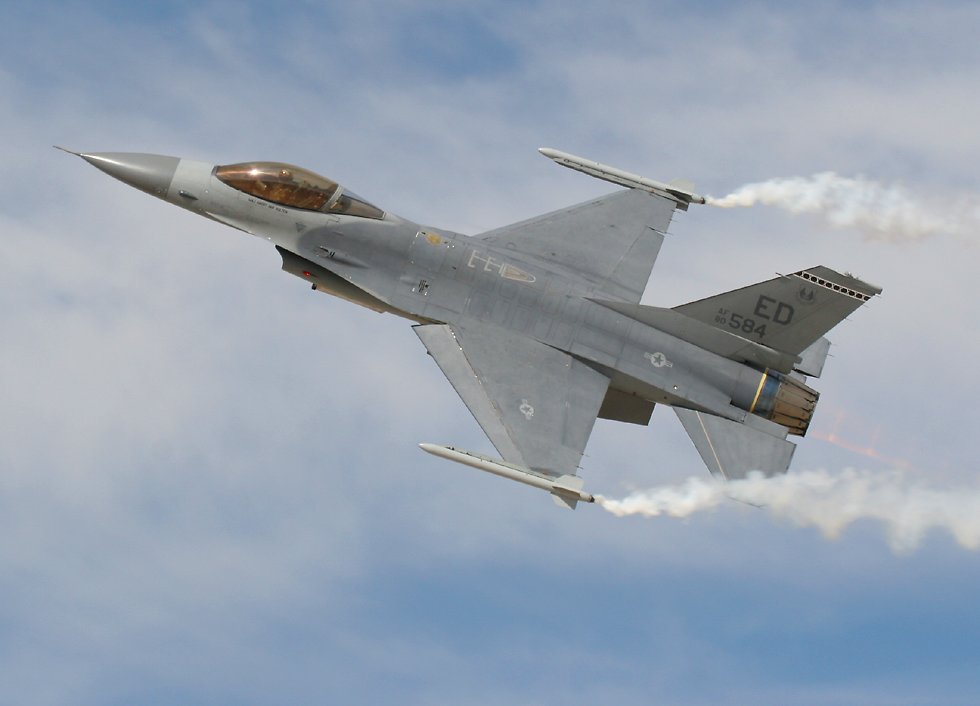 |
|
Here's
the USAF's most exciting new aircraft, the
F-22 Raptor air superiority fighter. This is a replacement for the ageing F-15 Eagle, which is still considered by most people to be the world's best fighter aircraft. The Raptor has significant advantages over the Eagle, including the ability to "supercruise" at about Mach 1.5 without using its afterburners, and the same type of stealth technology already employed on the F-117 Nighthawk and the B-2 Spirit. You shouldn't be too surprised to hear that both the F-15 and the F-22 made their first flights at Edwards, the F-15 on July 27, 1972 and the YF-22 on September 29, 1990. Oh, and the B-2 made its maiden flight here on July 17, 1989! |
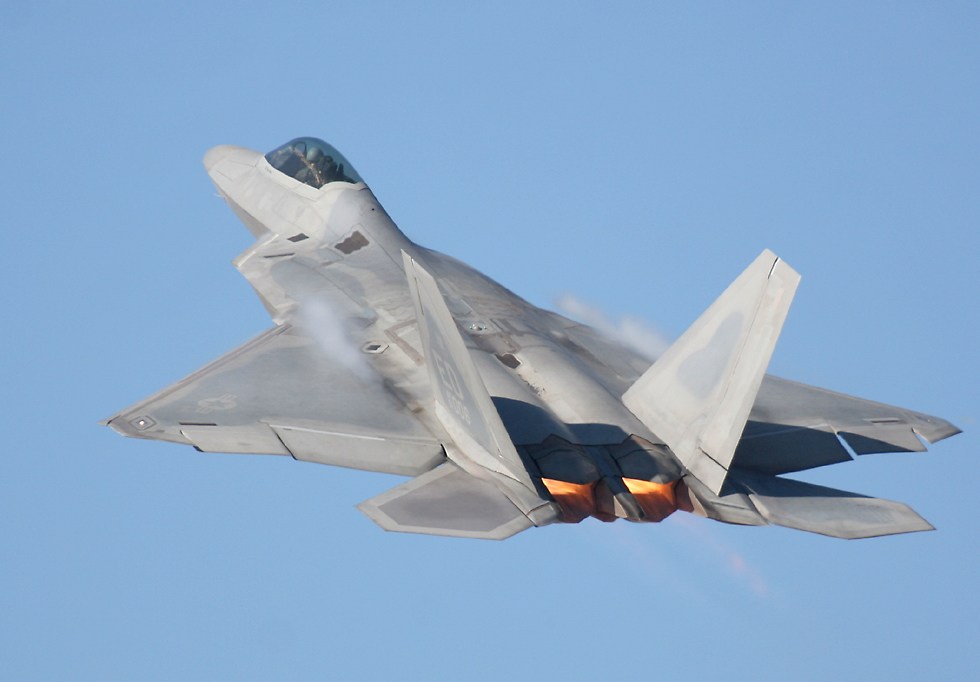 |
|
Not
only are interesting aircraft types on display at Edwards, but the displays tend to be more interesting than at other shows, perhaps partially because this is the air force's test center and also because there's an awful lot of empty space here, with little danger of damage on the ground in the extremely unlikely event that something goes wrong. As an example, Edwards is probably the only show anywhere where you'll see a pass by a Raptor with all of its weapons bays open. Officially, the Raptor is designated the F/A-22 Raptor to signify that it has abilities both as a fighter and as an attack aircraft able to bomb ground targets. In practice this is a claim forced on the military and its contractors by politicians wanting to make a name for themselves as defenders of the public purse - the Raptor was designed as a pure air-to-air fighter aircraft, and while it is able to carry a small quantity of bombs within these bays, its capacity is far lower than less high performance but more versatile aircraft like the F/A-18 Hornet. To carry more ordnance the Raptor has to use external bomb racks which almost completely obliterate the aircraft's stealthy characteristics, as well as affecting its ability to supercruise. |
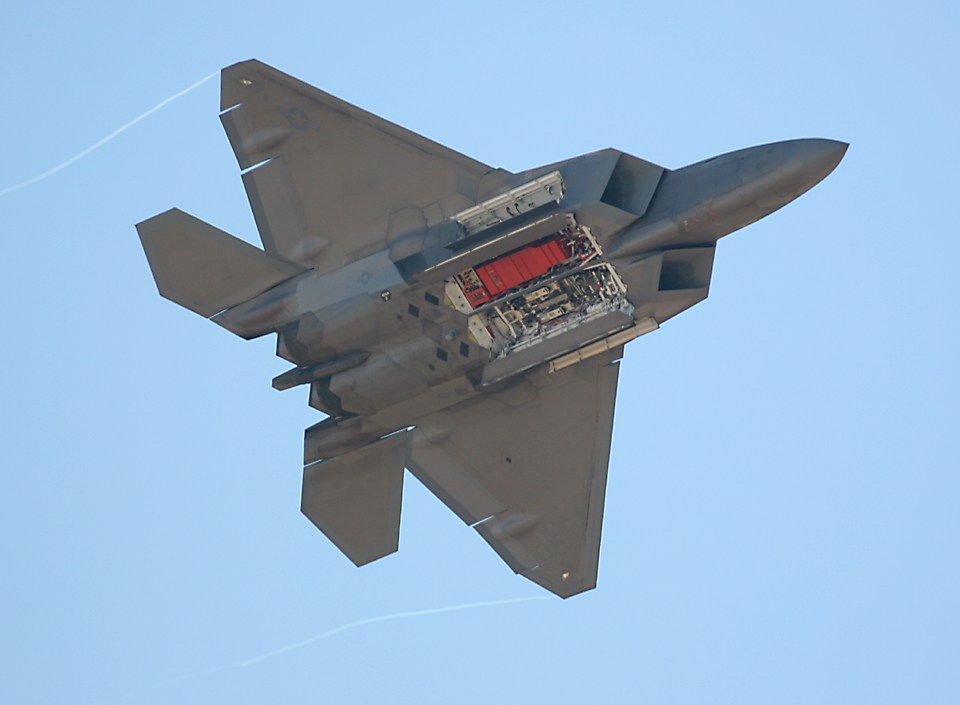 |
|
Like
the Stratotanker, the B-52 Stratofortress was designed by Boeing and entered
service in the mid 1950s, and like the Stratotanker it has a surprisingly bright future. Continually updated since they were first introduced, these two dinosaurs are expected to remain in service for several more decades. |
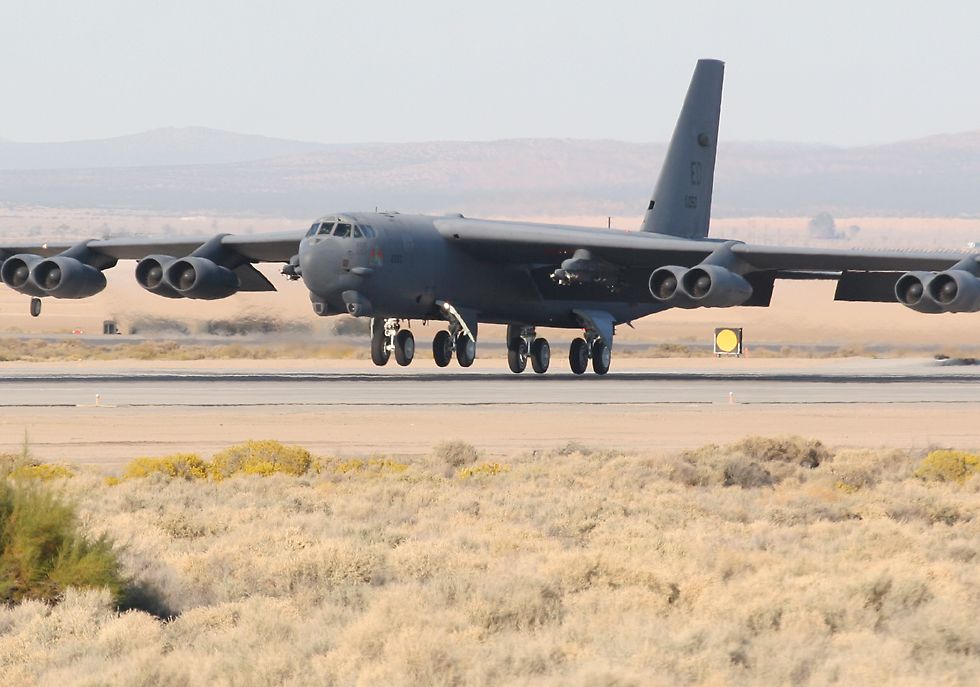
|
|
Although
the B-52 frequently appears at airshows as a static exhibit, it's not too
often that members of the public get to see a full display, taking off, doing multiple passes and landing at the same place. Not only did this demonstration include separate passes with landing gear down and bomb bays open, but after one pass they also did this rapid climb out, which I've never seen before. It certainly gives a different perspective on the Stratofortresses massive 185 foot (56.5 meter) wingspan. |
 |
|
The
B-1B Lancer looks like it should have made the B-52 totally obsolete, and
on paper it certainly looks like a worthy successor, able to carry almost 135,000 pounds (61 tonnes) of ordnance compared to the B-52's 70,000 pounds (32 tonnes), and able to fly at Mach 1.2 against the B-52's top speed of Mach 0.86. The Lancer also has a much lower radar signature and far better electronics. |
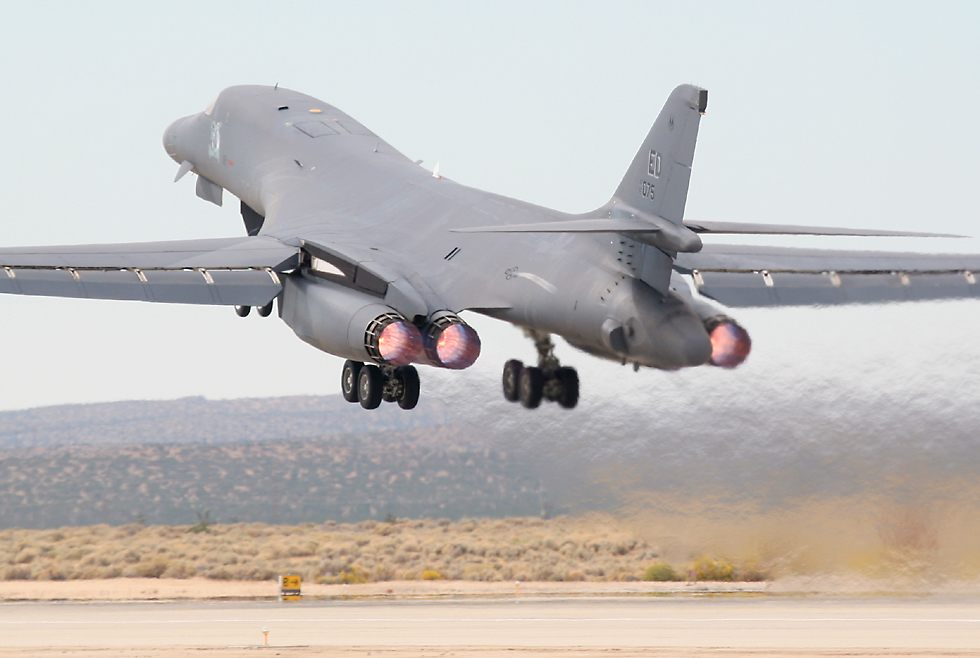
|
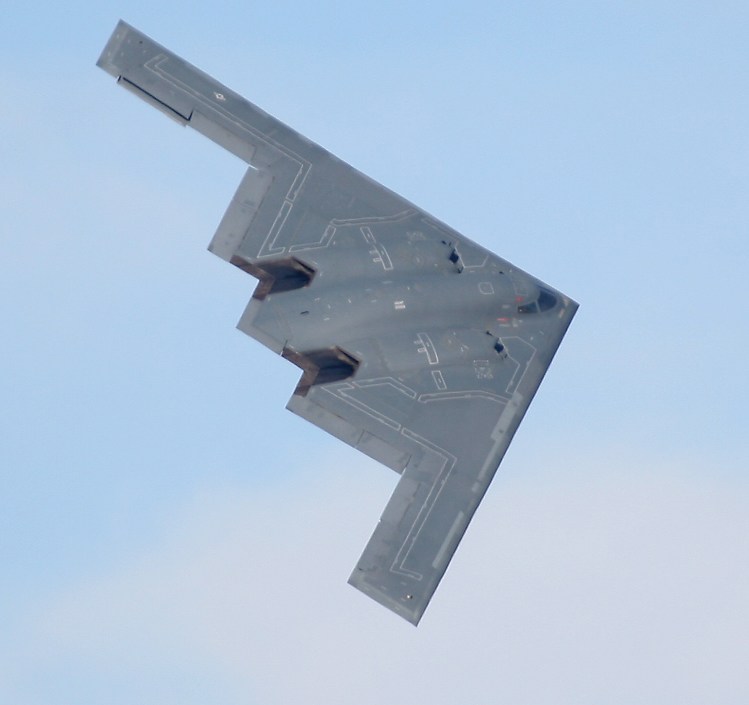 The B-1 might be far more technologically advanced than the B-52, but it
has an even more sophisticated counterpart in the B-2 Spirit, which is
popularly called the "stealth bomber". The B-2 demonstration
at Edwards is far better than the one put on at other airshows, so I've
put together an entire page about the
stealth bomber display at the 2005 Edwards AFB airshow.
The B-1 might be far more technologically advanced than the B-52, but it
has an even more sophisticated counterpart in the B-2 Spirit, which is
popularly called the "stealth bomber". The B-2 demonstration
at Edwards is far better than the one put on at other airshows, so I've
put together an entire page about the
stealth bomber display at the 2005 Edwards AFB airshow.
This crazy looking aircraft was designed to penetrate heavily defended territory which would be too dangerous for the B-1 or B-52, however some critics say that since the collapse of the Soviet Union it no longer has a credible opponent (a charge which is also levelled against the F-22 Raptor). It has almost exactly the same maximum speed as the B-52, but can only carry 40,000 pounds (18 tonnes) of ordnance compared to the B-52's 70,000 pounds or the B-1's 135,000 pounds. |
|
Completing the lineup of America's front-line aviation weaponry is this
F-117 Nighthawk, commonly known as the "stealth fighter". It would actually be more accurate to say that this is a YF-117A Nighthawk, since this is the third prototype aircraft. This same aircraft was painted up in this US flag scheme in 1983, but since the Nighthawk was still a top secret project at that time, very few people ever saw it; however because this aircraft was due to be retired straight after this show, it was decided to paint it up again and put it on public display in this scheme for the first time ever. Just to say it again, this is the sort of display that makes the Edwards show so special - it's the only event in the world where you have any hope of seeing an F-117, a B-1, B-2, B-52 and F-22 all put on extended performances in the same place at the same time. |
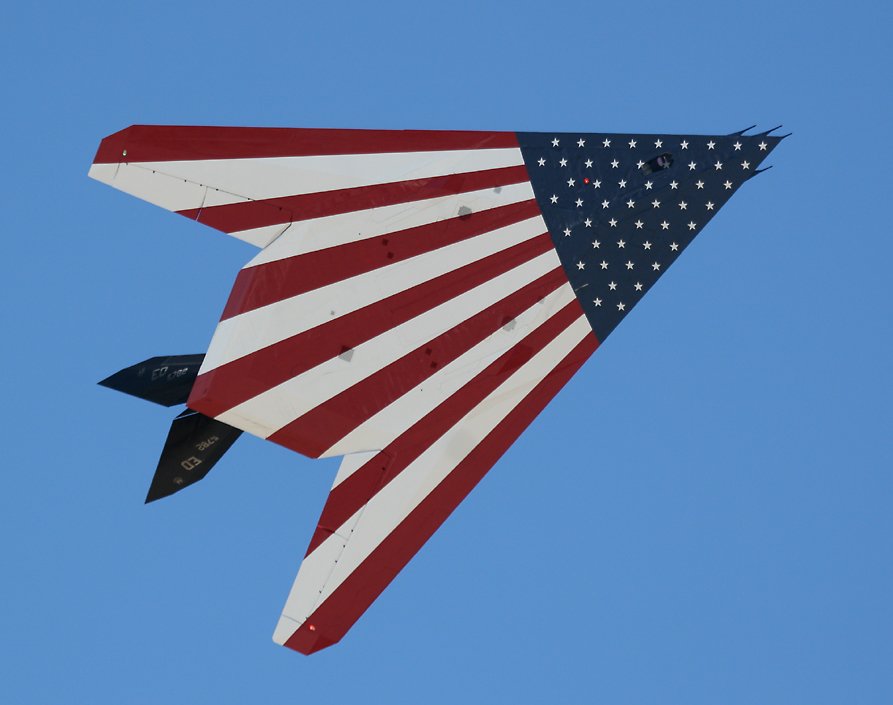 |
|
But
wait, there's more! Since many of the aircraft at Edwards are
test planes rather than combat aircraft, you'll also see paint schemes which are found nowhere else, like this very graceful T-38 Talon supersonic trainer, which is used as a chase plane to follow aircraft undergoing flight testing. This white scheme isn't one you'll see in too many other places. |
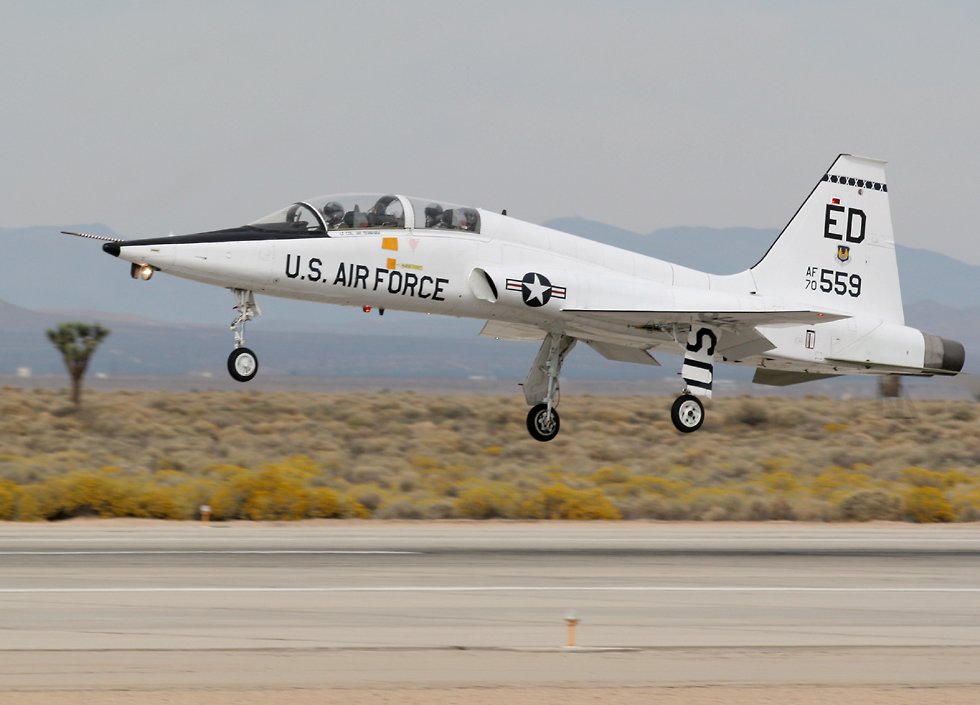 |
| Nor is the white-and-orange scheme on this two-seater F-16 Fighting Falcon likely to turn up in too many places! |
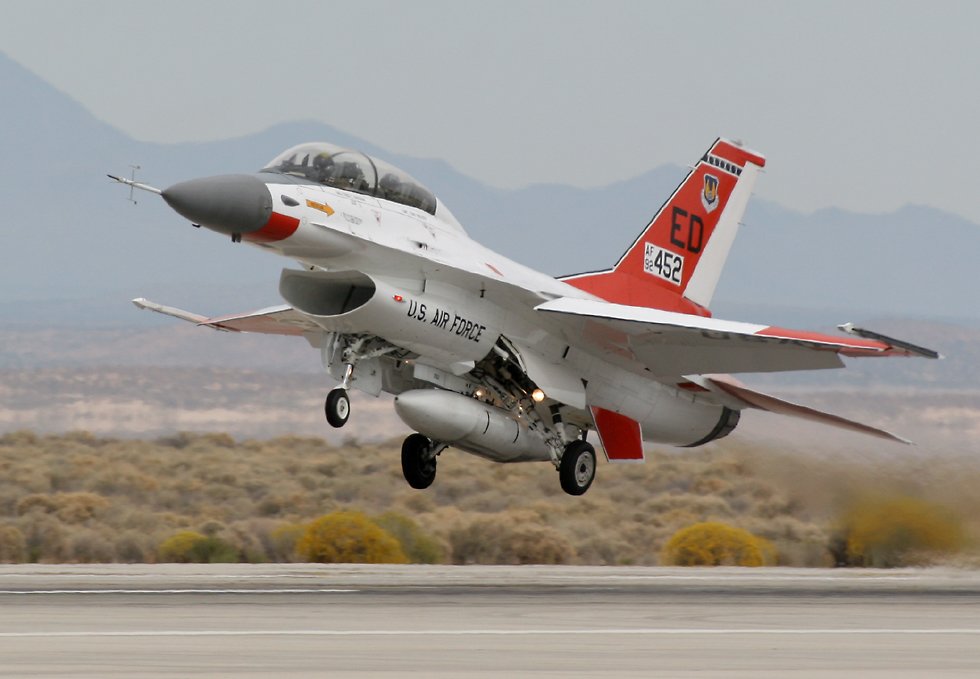 |
|
As
I mentioned earlier, NASA also has its Dryden Flight Research Center at
Edwards, so not only can you see interesting NASA color schemes, but you can see some unusual NASA aircraft as well. Several were on static display, and they also flew one of their F-18 Hornet chase planes (which was itself chased by a NASA T-34 Mentor), as well as some real oddities, like this highly modified F-15 Eagle code named ACTIVE, which not only has large auxiliary canard wings near the front, but also has thrust vectoring engines like on several of the Russian fighter aircraft which displayed at the 2005 MAKS airshow in Moscow. The ACTIVE F-15 also has an "intelligent flight control system" which consists of an adaptive neural network which is intended to allow the aircraft to continue to fly even after it suffers serious damage in flight which would otherwise cause the plane to crash. It has to be said that the F-15 is already able to survive a great deal of damage and keep flying even without a computerized neural network - an Israeli air force F-15 had a mid-air collision with an Israeli A-4 Skyhawk, but the pilot was able to bring the Eagle in for a safe landing even though it had lost nearly its entire right wing! |
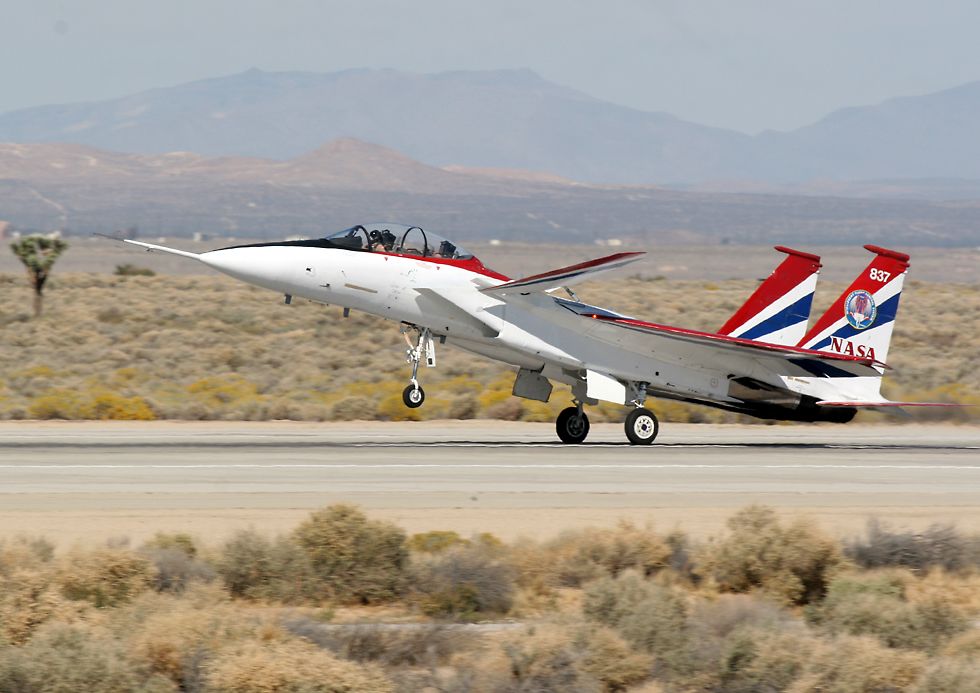 |
|
Here's
another interesting and unusual NASA aircraft, an ER-2 high-altitude research
plane, which was derived from the U-2 spy plane. This shot of it taxying towards the crowd area after performing its demonstration shows off its glider-like wingspan of over 103 feet (33 meters). The aircraft has a bicycle landing gear with two sets of wheels mounted fore and aft under the fuselage, so before liftoff and after landing a support truck trails it, to retrieve and later refit the flimsy "pogo stick" landing gears which you can see about half-way along each wing. These wheels fall off automatically at takeoff, but are put back on after the pilot slows the plane to a crawl and allows one wing to dip towards the runway. All of this happened during the show, and I was also lucky enough to see the same thing about 10 years ago when I was still living in New Zealand, where NASA was doing ozone hole research. |
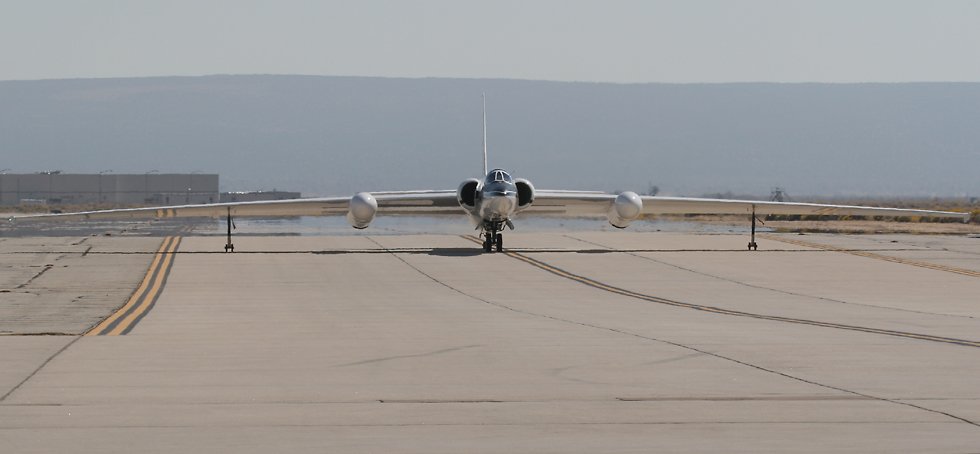 |
|
Another
speciality of the Edwards show is the mass flyby done by many different
air force aircraft types. This year the display consisted of a C-12 Huron, B-2 Spirit, KC-135 Stratotanker, MC-130 Hercules, C-17 Globemaster III, B-52 Stratofortress, the American flag F-117 Nighthawk, F-16 Fighting Falcon, T-38 Talon, the F-16 Fighting Falcon in the white and orange color scheme which you saw earlier on this page, and the F-22 Raptor. It's a really spectacular display. |
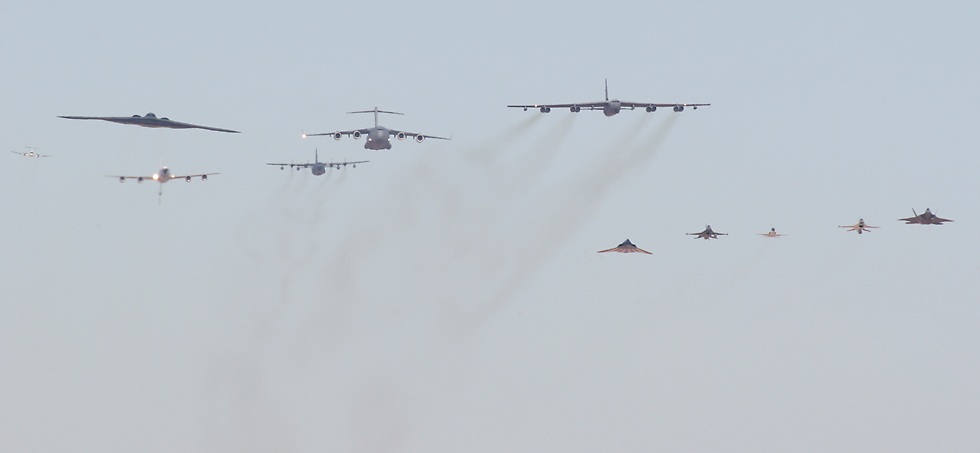 |
Highlights of the 2005 Nellis AFB "Aviation Nation" Airshow
|
The theme of this year's show was "Welcoming Home Our Vietnam Veterans" and
an excellent collection of Vietnam aircraft was put together, better even than the similarly-theme Selfridge ANGB airshow earlier in the year. Leading the way was a flight of iconic aircraft from the Vietnam conflict, the ubiquitous UH-1 Iroquois, better known as the "Huey". Three Hueys thudded their way past the crowd line each day, including these two in close formation. |
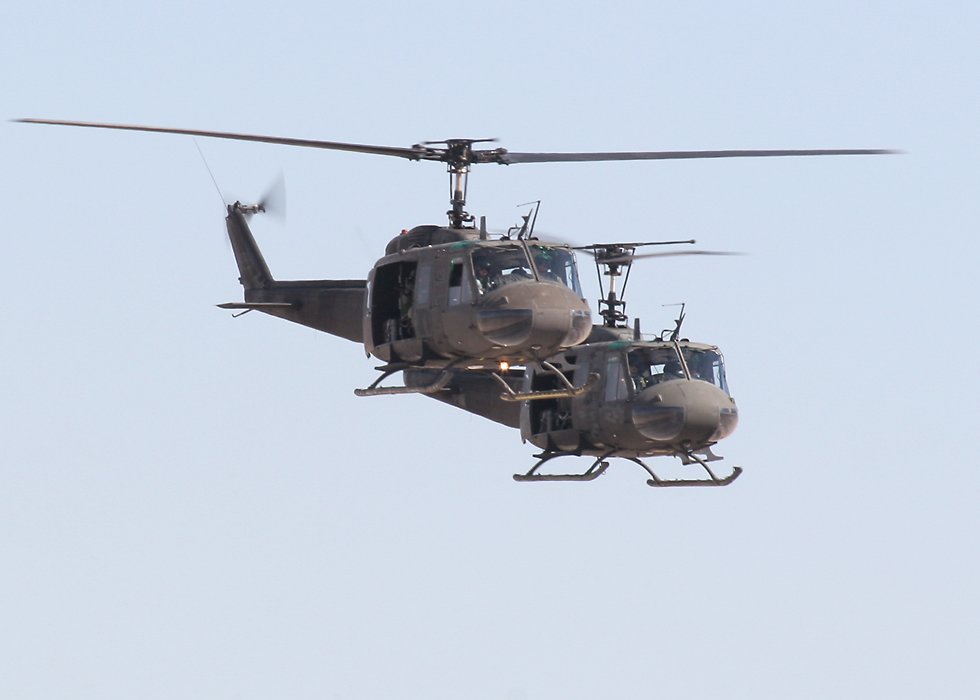
|
|
The iconic fixed wing aircraft of Vietnam was probably the F-4 Phantom II,
which flew with the air force, navy and marines. This particular aircraft is a QF-4 Phantom II drone used as a target for missile testing, nicely painted up by the air force in a South-East Asia color scheme. The Collings Foundation operates an F-4D Phantom II in Vietnam colors, and I was fortunate enough to do an air-to-air photo shoot of the Collings F-4 earlier this year. |
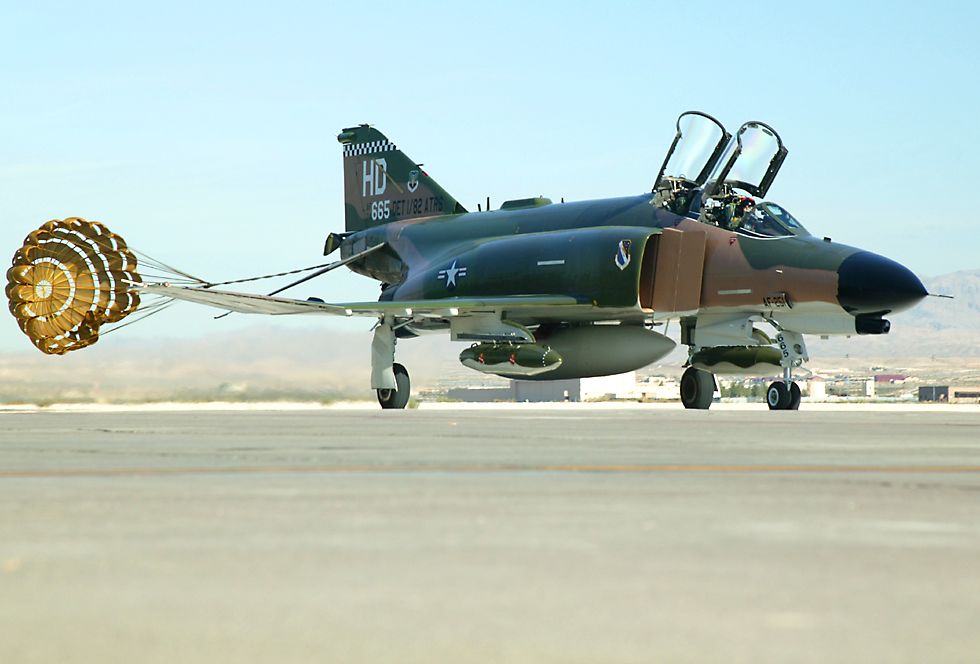 |
|
This OV-10 Bronco is far less well known than the Huey or the Phantom.
It was the first American aircraft specifically designed for the forward air controller and observation roles; prior to this time conversions of civilian aircraft like the O-1 Bird Dog and O-2 Skymaster were used in Vietnam. The Bronco was far more capable than either the Bird Dog or Skymaster, with higher speed, better protection for the pilots and greater firepower like the machine guns you can see here sticking out of the sponsons under the fuselage. It's very rare to see one at an airshow, so it was nice to see this aircraft registered just last year by the Cactus Air Force here in Nevada. |
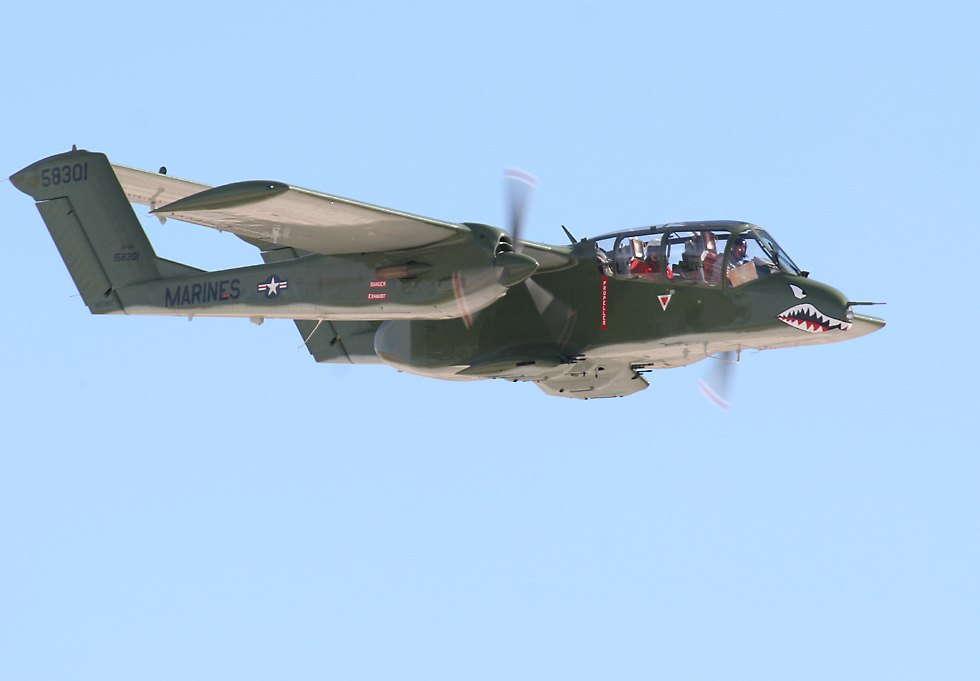
|
|
The Douglas Skyraider is a much more commonly seen aircraft on the airshow
circuit, at least in its navy or marine incarnations. The Skyraider first flew during world war two, but its heavy load capacity and long loiter time made it ideal for later conflicts, and it was used a great deal during the Vietnam war. Here you see the one-man marine corps AD-4N version, and the seldom seen four-man A-1E used by the air force. |
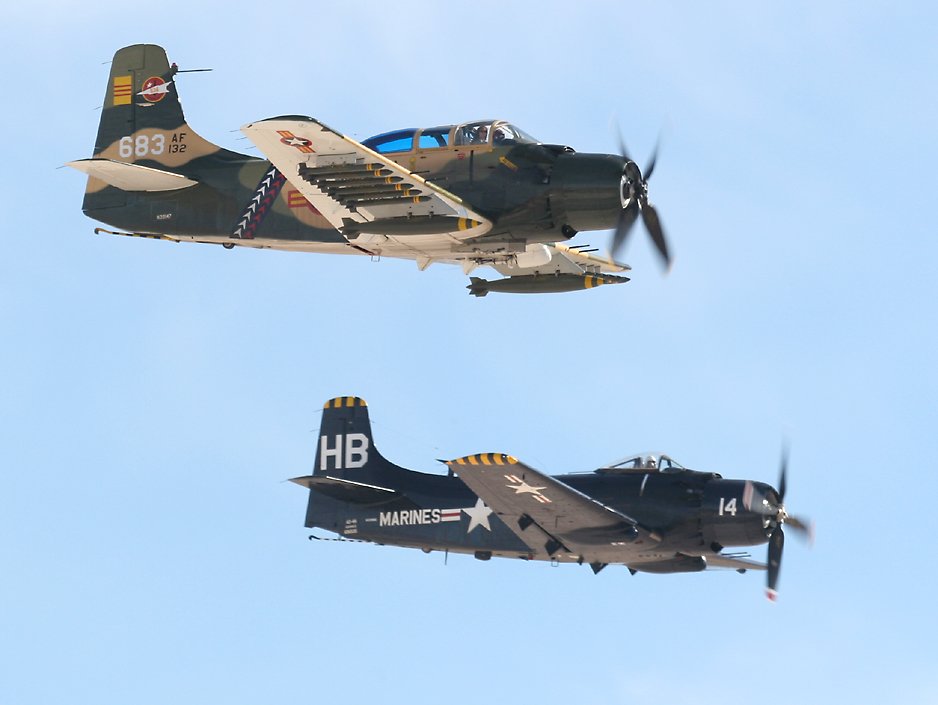 |
|
This particular A-1E is one of the mostly nicely restored Skyraiders in operation,
the simulated ordnance provides a lot of extra interest, specially during the type of simulated bombing combat mission which was provided at the show by Chris Rainey and the rest of his pyrotechnic crew. |
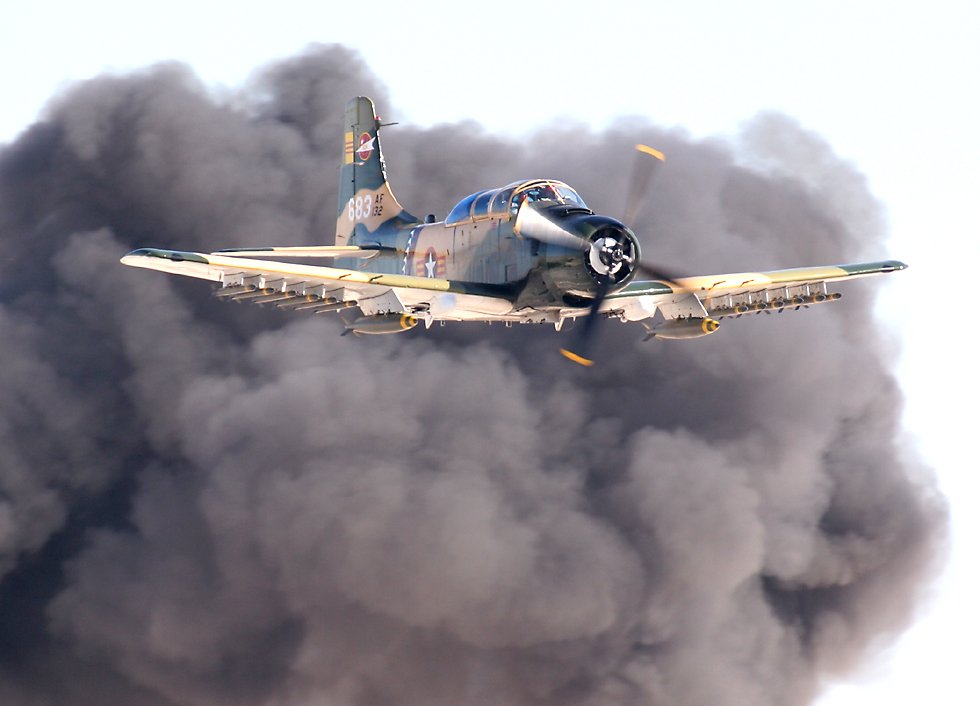
|
|
The Cessna aircraft corporation was responsible for the Bird Dog and Skymaster,
but they also produced a few aircraft designed especially for the military, like this A-37 Dragonfly. Developed from the T-37 Tweet trainer, the A-37 performed ground attack work using the six-barrelled GAU-2B mini-gun which you can see extending from the top of the nose. Like the Skyraider, the Dragonfly can also carry an extraordinary load of munitions under its wings, which is part of the reason why it's still in service with several South American air forces. |
 |
|
You might think that this plane doesn't belong in a Vietnam war remembrance,
but in fact this AC-47 gunship, commonly referred to as "Spooky" or "Puff the Magic Dragon", is very familiar to people who know about this conflict. Basically a world war two vintage C-47 Skytrain transport armed with 3 miniguns, these gunships could pour an enormous amount of firepower onto ground targets, usually Viet Cong forces besieging a military base or village. |
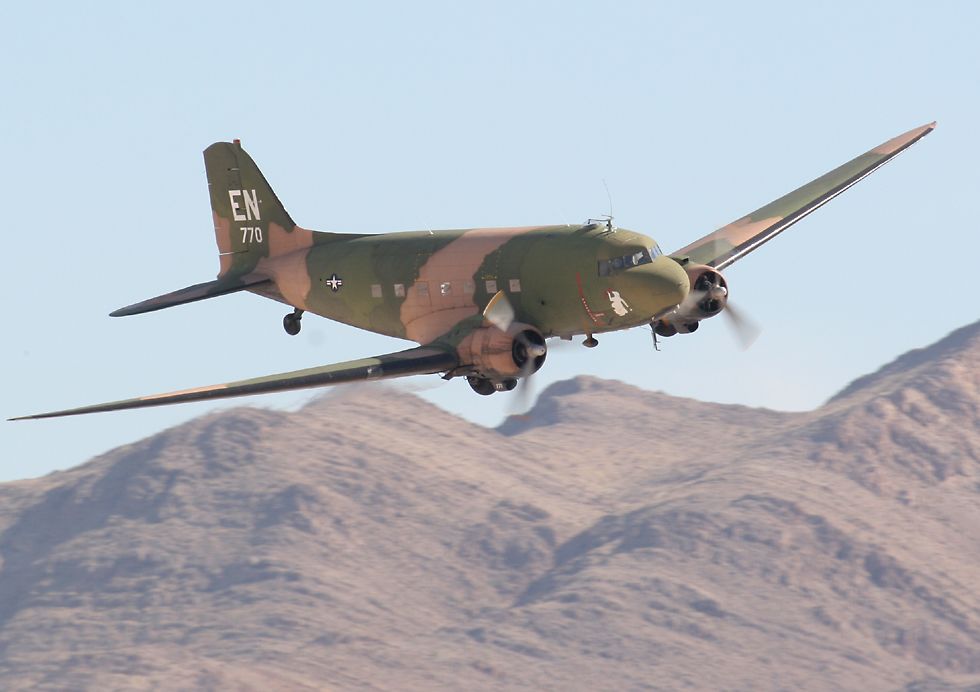 |
|
Because of the theme of this year's show, the pre-Vietnam warbird lineup was emphasized
less than in previous years, as was the simulated Reno Air Race which is held each year; nevertheless there was still plenty on offer for aerobatic fans and those interested in military aircraft from other eras. |
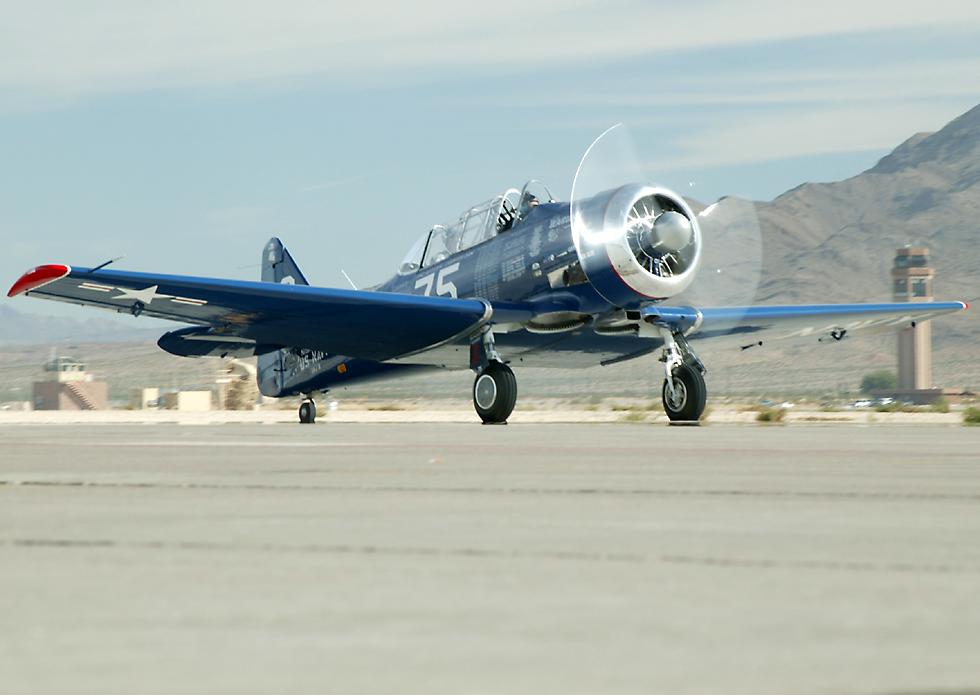 |
|
This B-25 Mitchell bomber was one of the world war two aircraft which flew on
the day, together with the P-51 Mustangs "Six Shooter" and "Val Halla". |
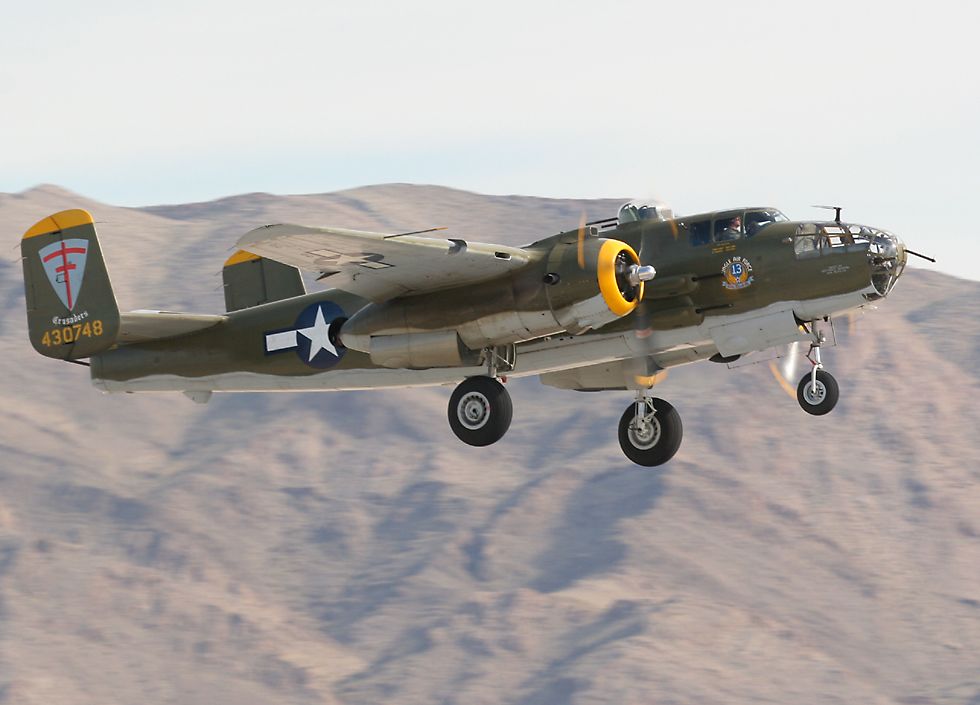 |
|
There was also plenty of entertainment for people who need their fix of modern
military aircraft turning and burning, with spirited demonstrations like this one by an F-15 Eagle, as well as a display by its counterpart the F-16 Fighting Falcon. |
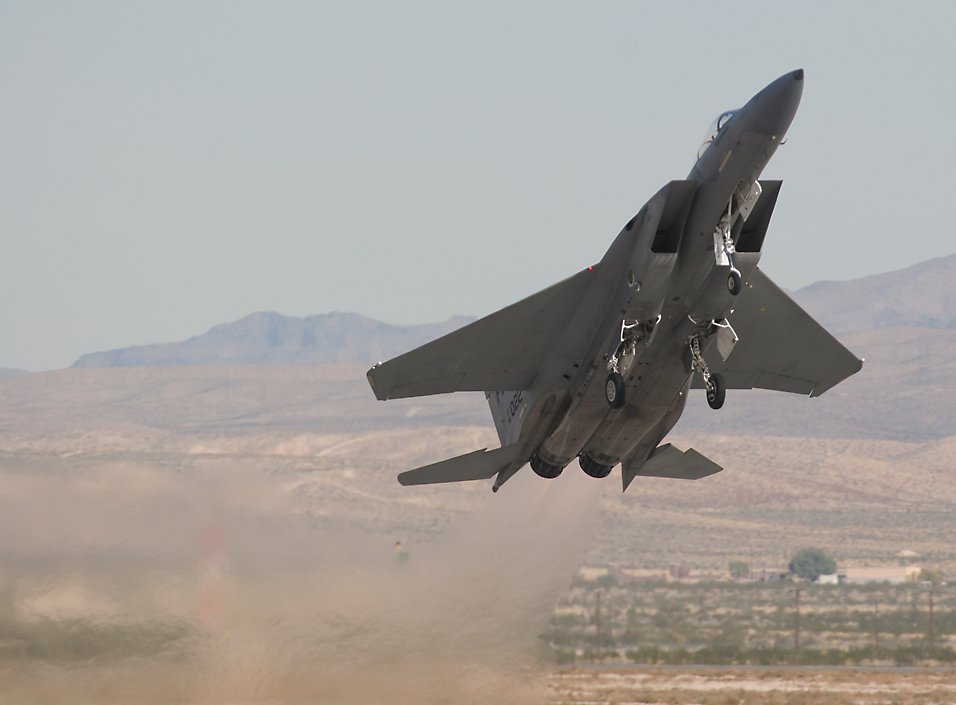
|
|
The Eagle was very good, but the air force's latest air superiority fighter
definitely stole this section of the show. The F-22 Raptor flew at last year's Nellis airshow, but restricted its display to high flat passes and steep climbs far from the crowd area. It seemed that the air force might be following the policy pioneered by the F-117 Nighthawk "stealth fighter" and B-2 Spirit "stealth bomber", only doing tame routines with these extremely expensive aircraft in order to reduce the risk of bad publicity in the event of an accident. |
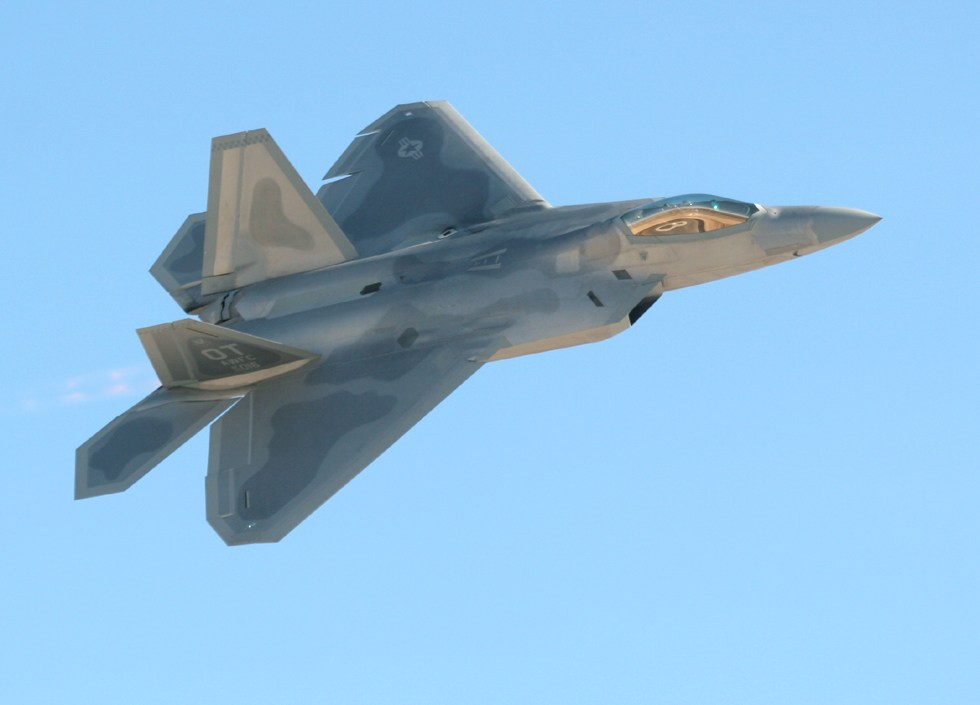
|
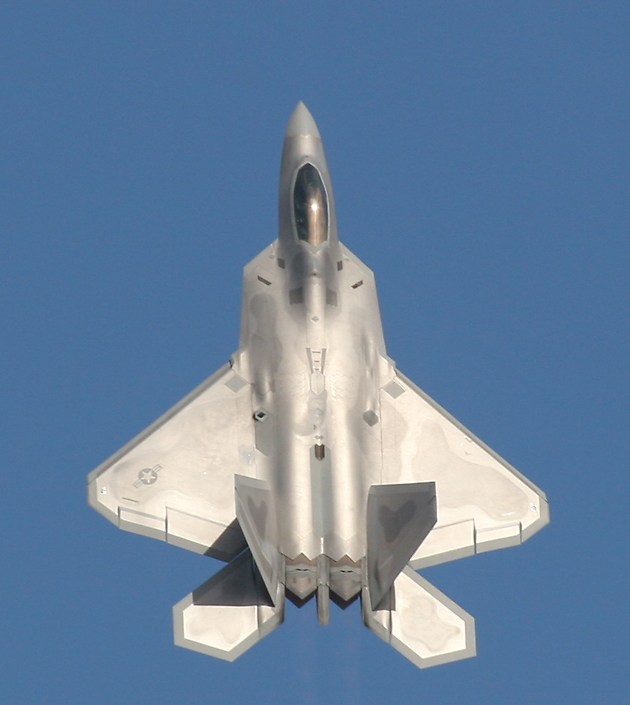 Thankfully, this year's display at Nellis threw this type of caution to the wind with
an excellent display of low takeoff passes, steep afterburner climbs and
banked passes also with afterburner.
Thankfully, this year's display at Nellis threw this type of caution to the wind with
an excellent display of low takeoff passes, steep afterburner climbs and
banked passes also with afterburner.
It's the type of performance which ardent aircraft fans hope will get better and better as this extraordinarily capable aircraft settles into regular service. |
|
The airshow community can be thankful that the top brass also allowed the Raptor
to participate in the air force's Heritage Flight program, pairing today's top of the line hardware with their equivalents from earlier times, like this world war two P-51 Mustang. |
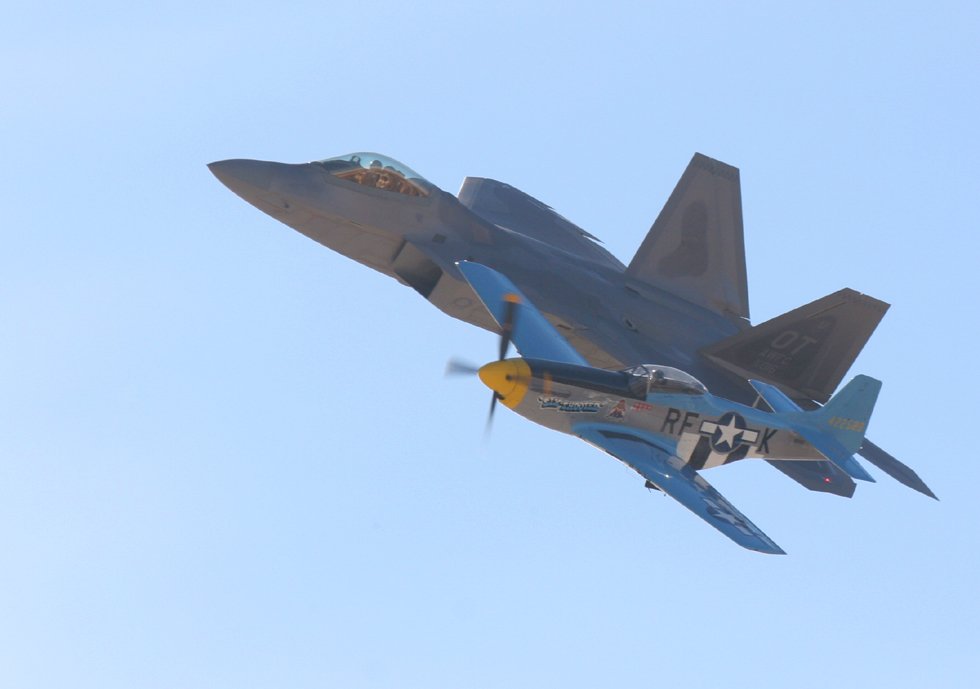 |
|
Since this show had a Vietnam theme, it was extremely appropriate that fighters
from three generations should be flown together. |
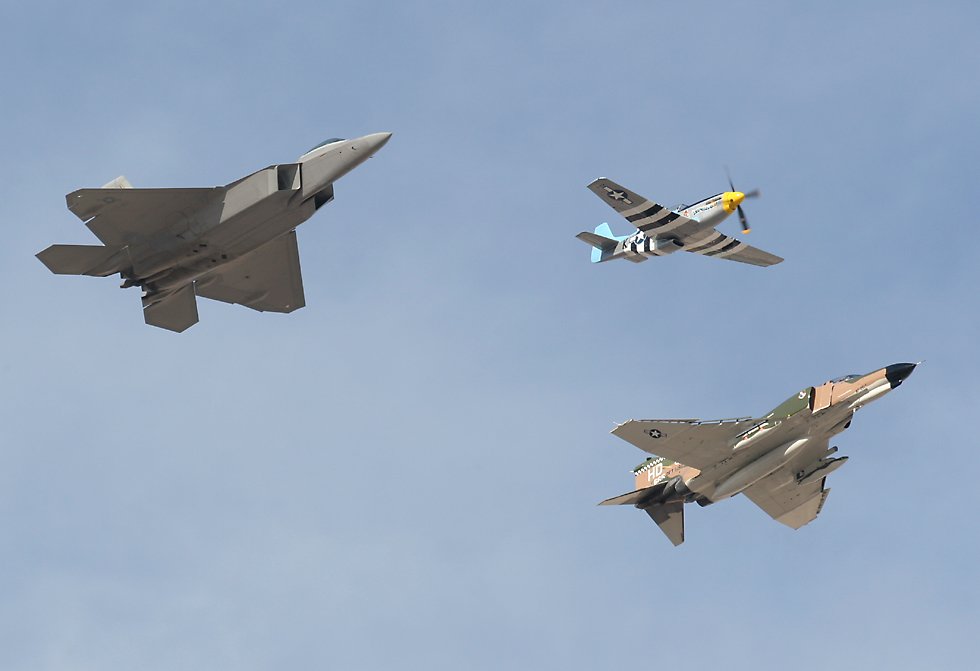
|
|
There was one other Vietnam era plane which flew at the show, a Russian designed
MiG-17 "Fresco" as flown by the North Vietnamese air force. It's great to see aircraft like this flying, though for purists like myself it's maybe not so good to see them plastered over with capitalist advertising! Of course the great majority of the audience doesn't care about details like that, and the owner and pilot, Bill Reesman, does an excellent display, as you might expect from someone who flew 320 combat missions in Vietnam flying the F-100 Super Sabre. |
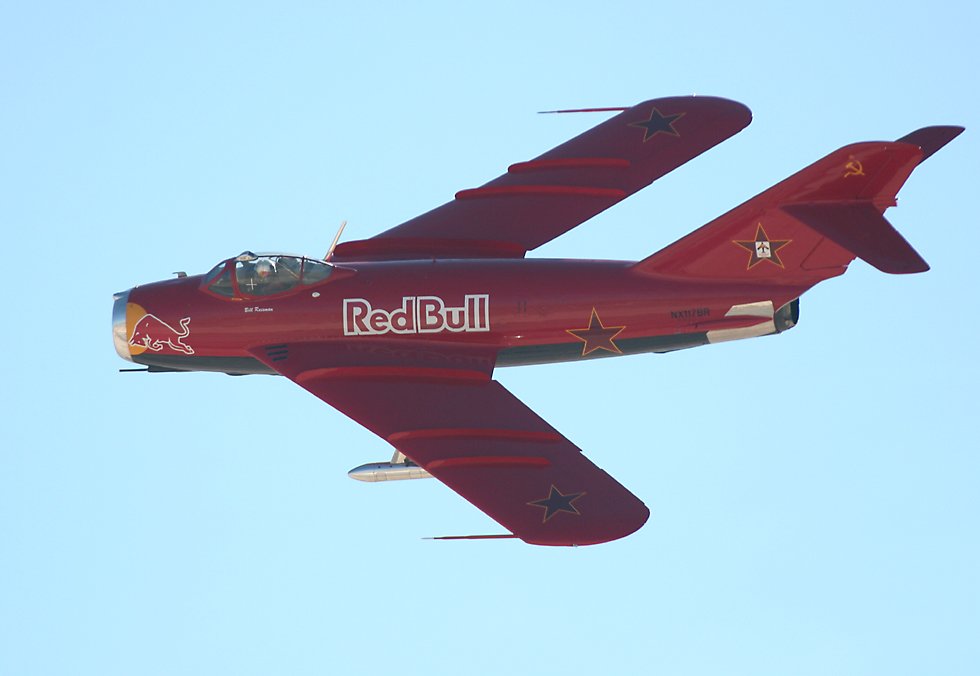 |
|
Chris Rounds also does a good display in his sponsored T-33 Shooting Star trainer,
named The Red Knight after a Royal Canadian Air Force T-33 display aircraft which flew demonstrations for many years in the same colors. |
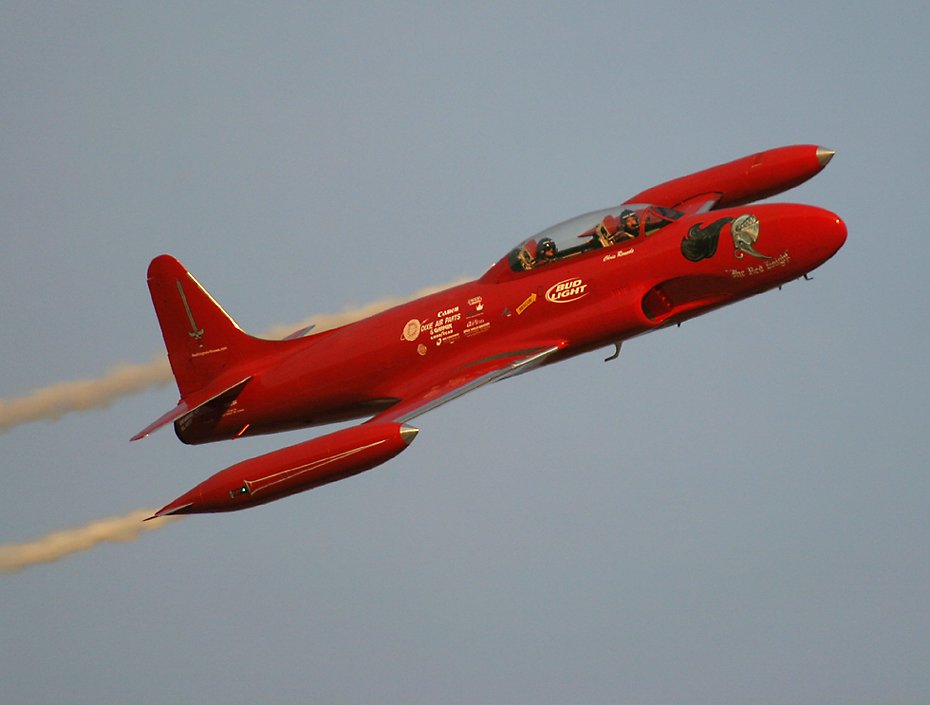 |
|
There were no Canadians flying at this show, but the USAF Thunderbirds display
team is based at Nellis air force base and always does its end of the year homecoming performance at the show. This year's show included a surprising number of overflights of the crowdline by solo pilots, but the crowd loved the demonstration of what these aircraft can do. |
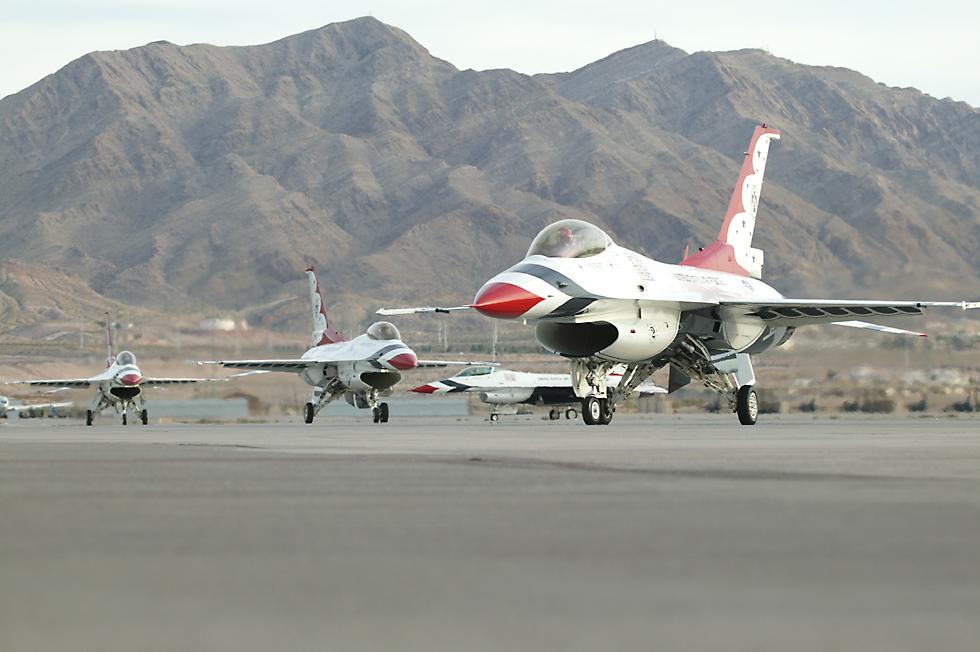 |
|
A performance of another kind took place in the late afternoon light - the
first ever display at an airshow by the Predator unmanned aerial combat vehicle, complete with pyrotechnics as the Predator did a simulated attack run using the inert hellfire missiles carried under its wings. In real life the Predator was first used in this way in Afghanistan in 2001 and again in Yemen in 2002. Nellis is one of the main centers for flying UCAVs, so it was very appropriate that there were several different models on static display. |
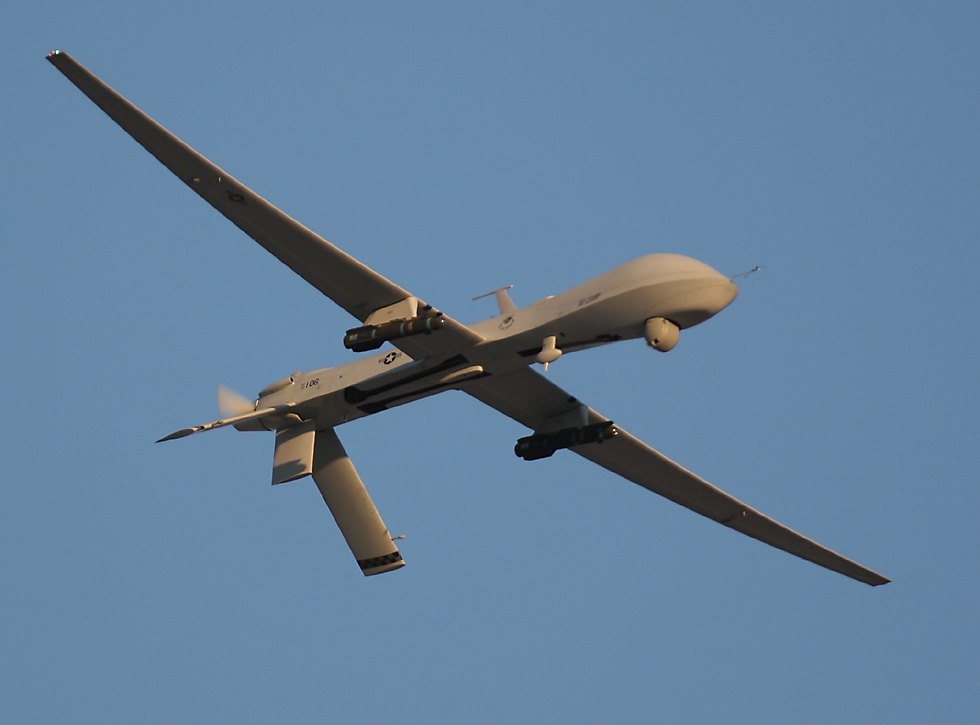
|
|
Before and after the flying there was plenty of time to browse the huge static
display of aircraft spread across the show grounds. This year's display was up to the usual high standard, with highlights including this restored 1930s Dornier Do-24 flying boat complete with modern turbo-prop engines, the historic C-141 Starlifter "Hanoi Taxi" used to evacuate POWs from Hanoi at the end of America's involvement in that war, and an EP-3 AWACS plane. There was a sad looking MiG-29 "Fulcrum" jet fighter near the entrance, sister ship to the pristine MiG-29 in the Threat Training Facility at Nellis; the folks from the TTF had a variety of hardware on display, including a scud missile. |
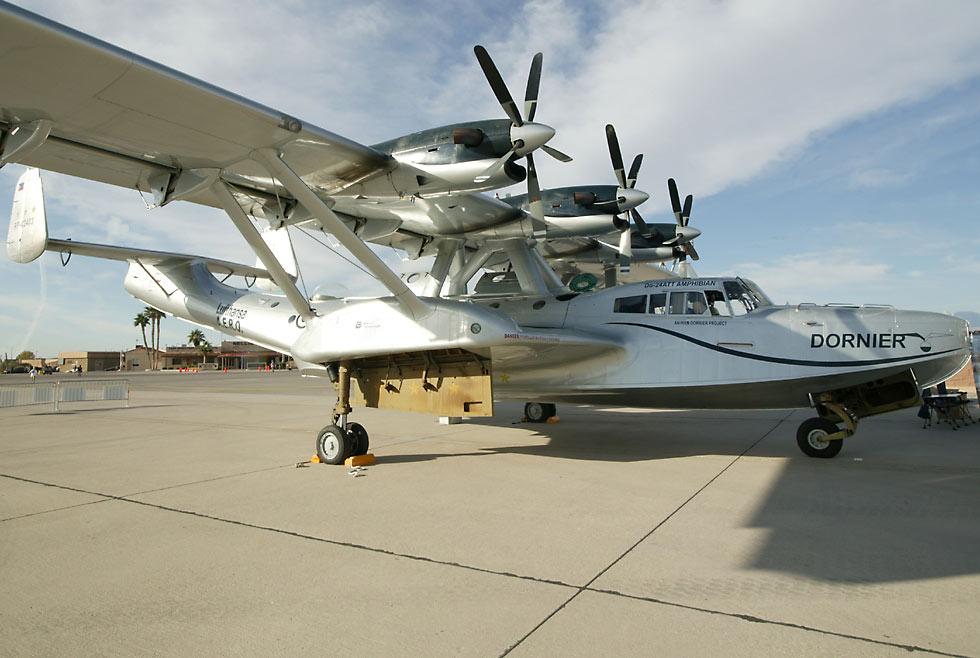 |
|
As always, many of the most interesting aircraft stayed on static display
and only flew when arriving and departing. I wasn't there for the main arrival and departure days, but several aircraft did sneak out on Sunday after almost everyone had left, including this great looking Grumman Albatross flying boat, which made its exit as the last of the day's sunlight vanished. |
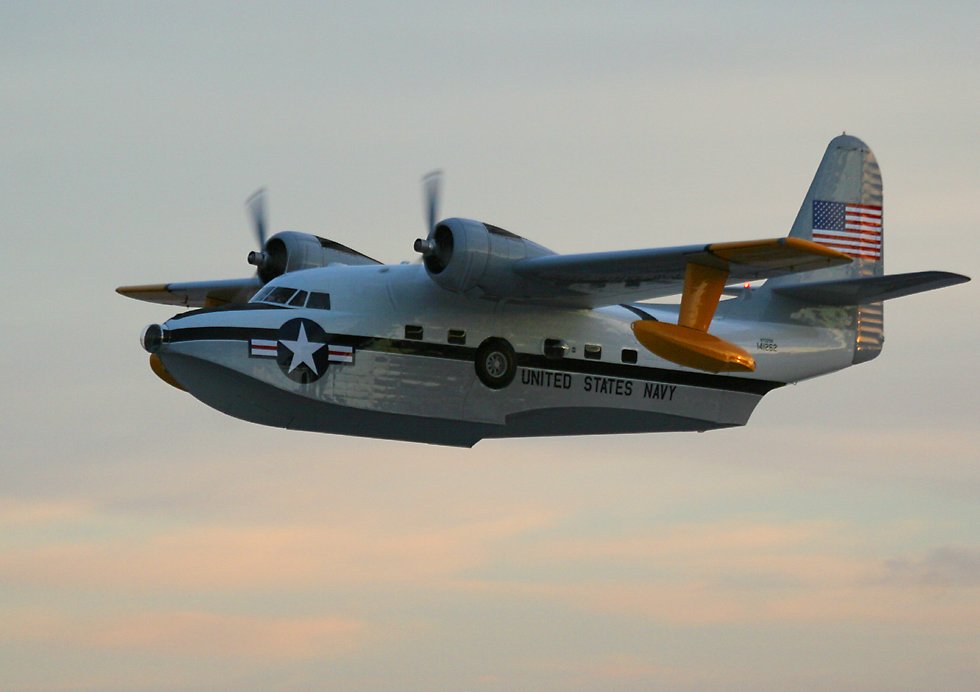 |




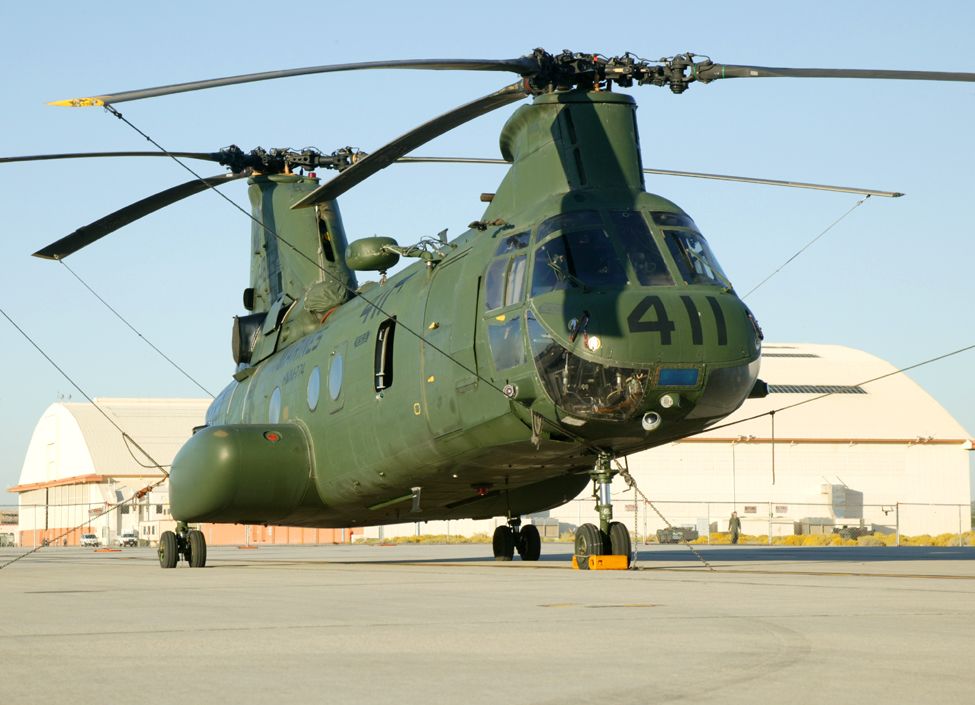
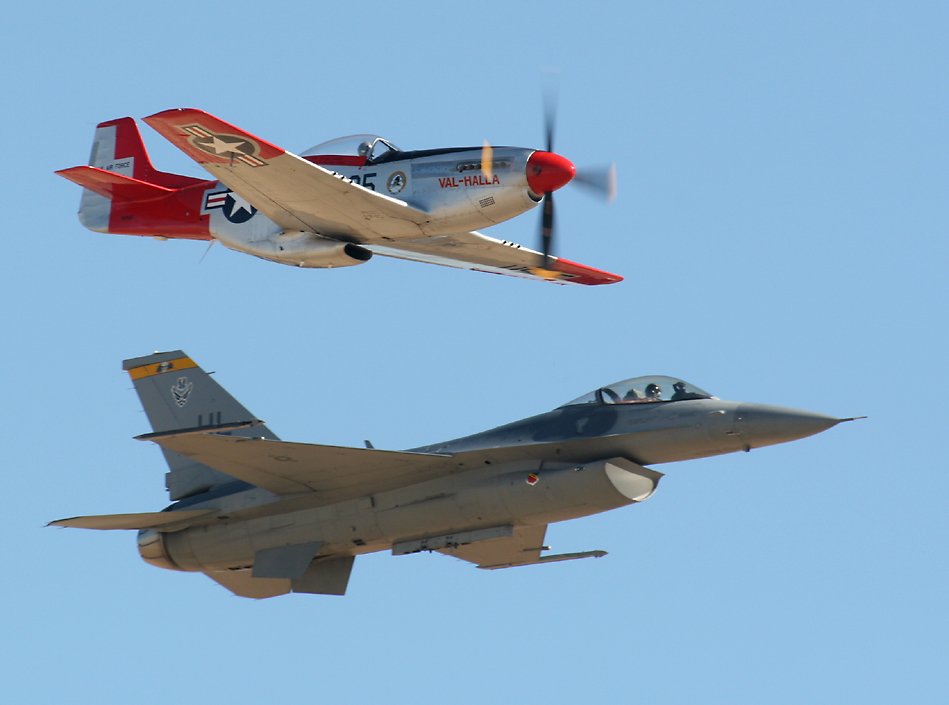
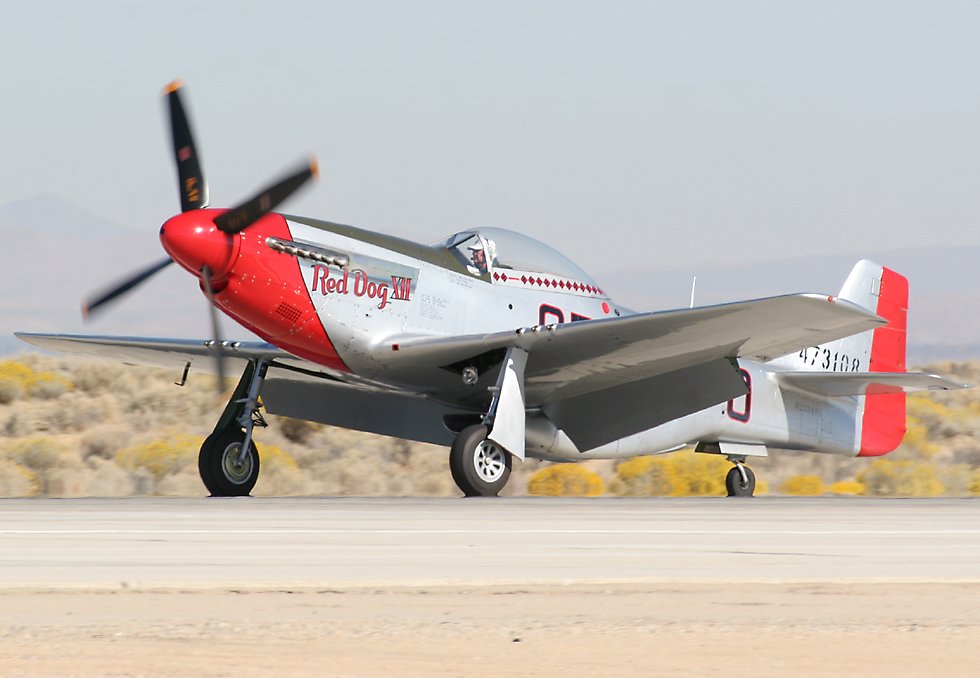
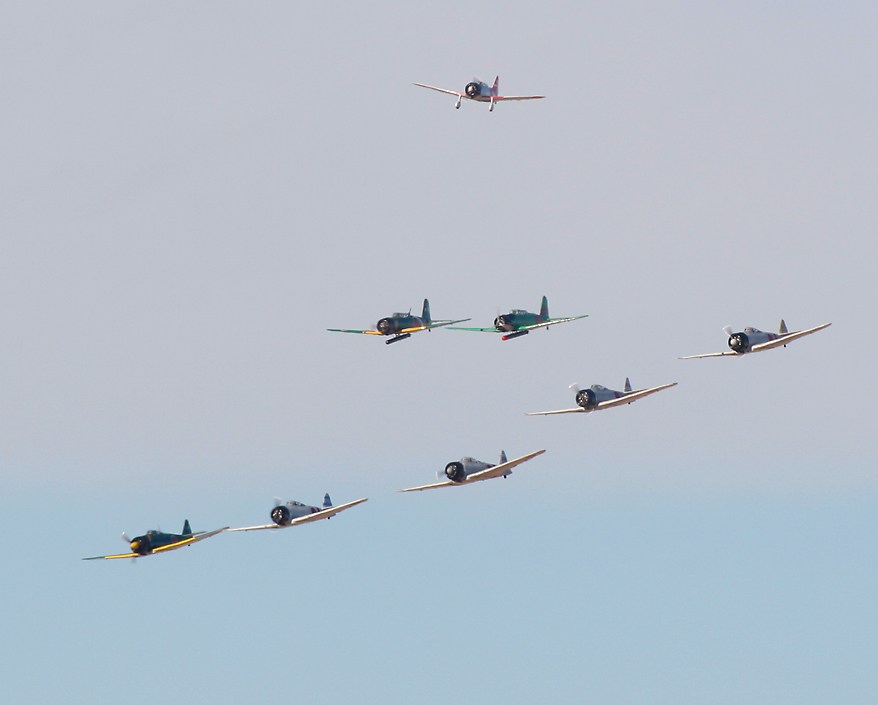
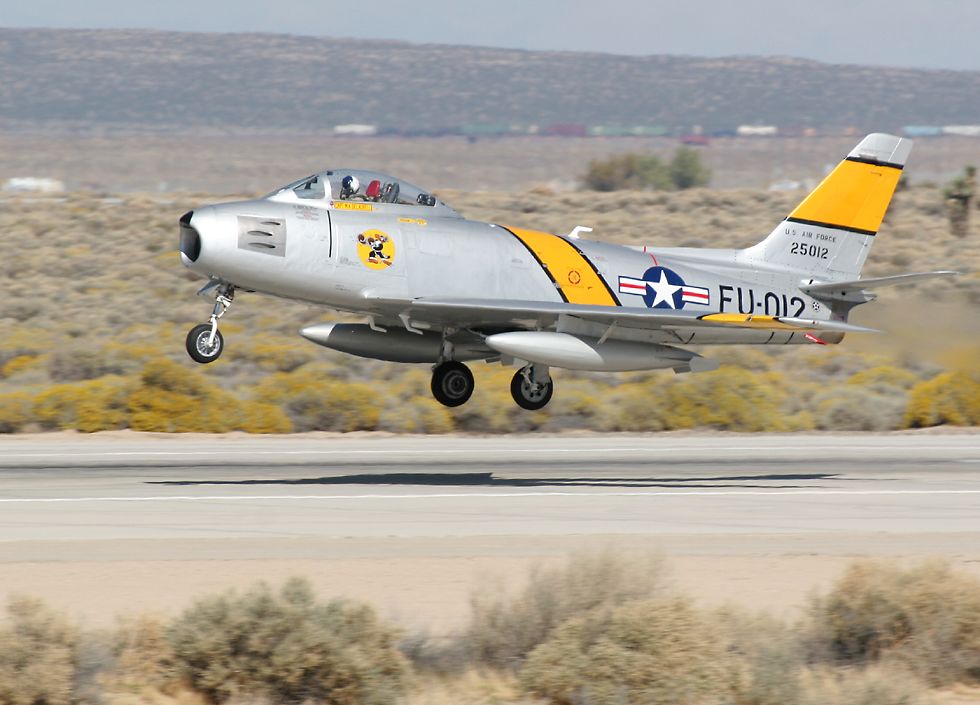
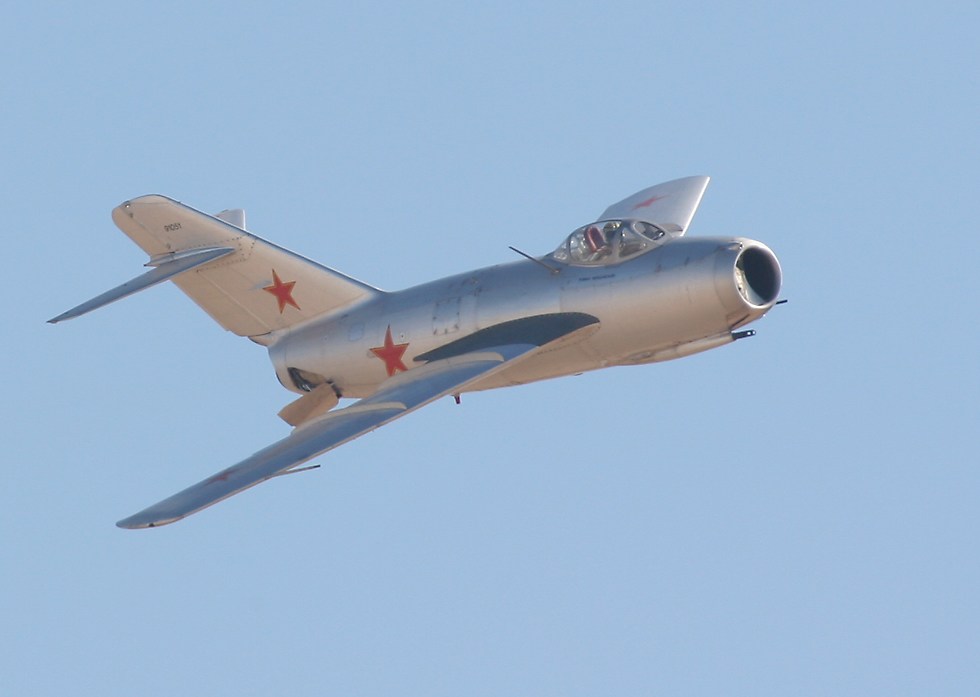
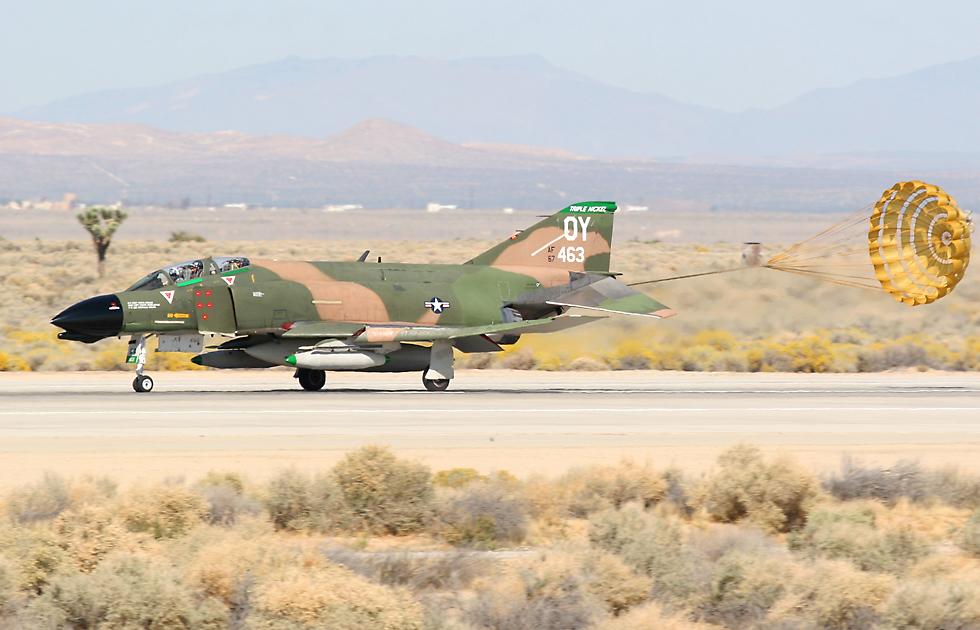
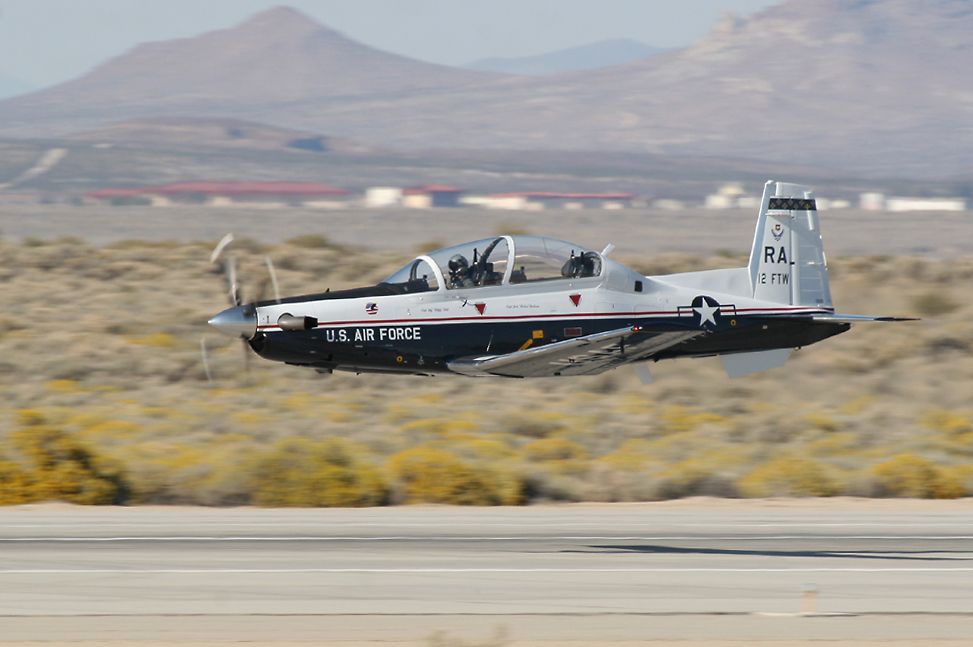
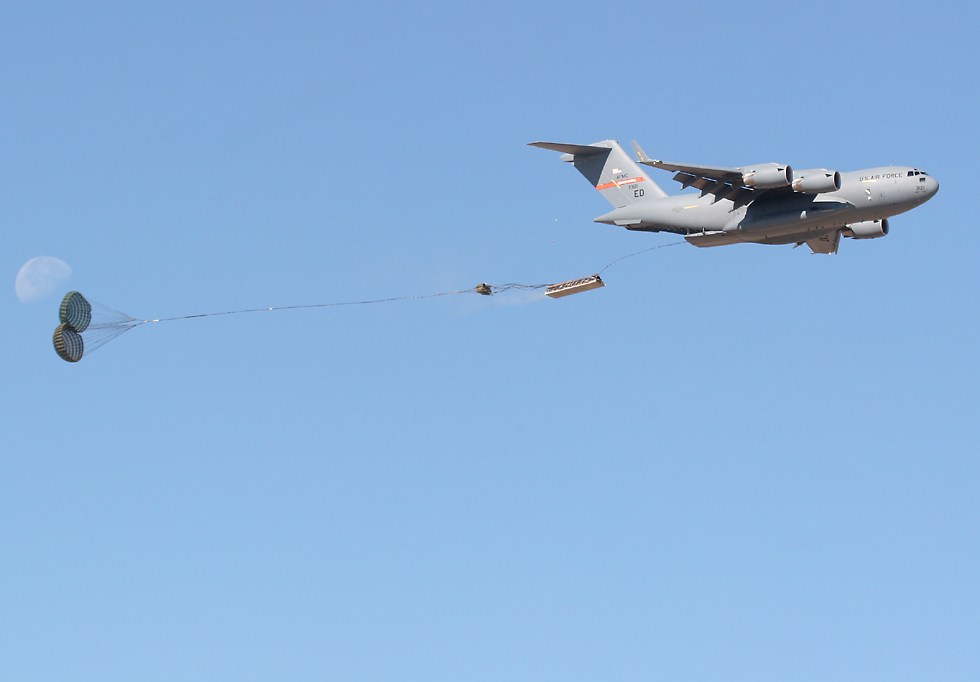
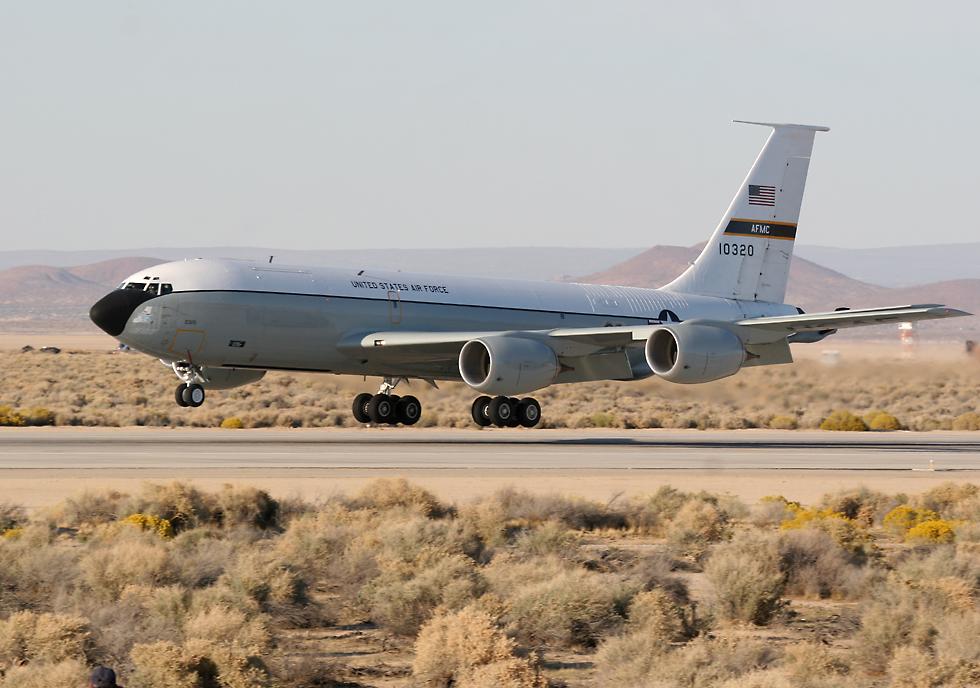

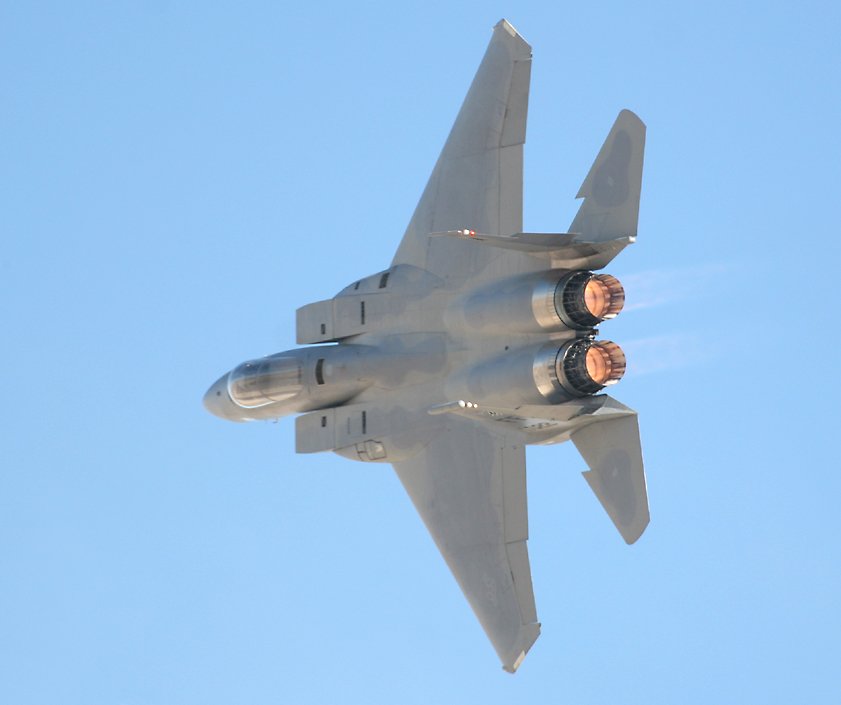
nasir_s2000@yahoo.com
ReplyDeleteThis comment has been removed by the author.
ReplyDeletemibrahimtajuddin@gmail.com
ReplyDeleteab25hk@yahoo.com
ReplyDeletemohammedkasim21@gmail.com
ReplyDeleteikshf143@gmail.com
ReplyDeletefarookhster@gmail.com
ReplyDeletejohnibrahim_ibm@yahoo.com
ReplyDeleteimtiyaz_kz@yahoo.com
ReplyDeleteillah1982@gmail.com
ReplyDeleteabdul.khaliq@emirates.com
ReplyDeletezaffar1987taj@gmail.com
ReplyDeleteshakirgulbarga@yahoo.com
ReplyDeletejbprho@yahoogroups.com
ReplyDeleterajeshkainth003@gmail.com
ReplyDeletea.amitkumar13@gmail.com
ReplyDeletemanisha.hatkar@gmail.com
ReplyDeletepreeti.hande@gmail.com
ReplyDeleteimmortally69@yahoo.com
ReplyDeletekaustubh.basu@gmail.com
ReplyDeleteplanetofprince@yahoo.com
ReplyDeleteabhi_bugs@yahoo.com
ReplyDeletefundtransfer_wnunion1@w.cn
ReplyDeleterajeshkainth003@gmail.com
ReplyDeletemujib_siraj@yahoo.co.in
ReplyDeleteconnecttohabi@yahoo
ReplyDeleteimtiyaz_kz@yahoo.com
ReplyDeletethinkb4uact_withfriends@yahoo.com
ReplyDeletekrrish_spider@yahoo.co.in
ReplyDeleteabbas006@hotmail.com
ReplyDeletezaffar1987taj@gmail.com
ReplyDeletekmohammad@munajem.com
ReplyDeletejohnibrahim_ibm@yahoo.com
ReplyDeletemibrahimtajuddin@gmail.com
ReplyDeleteyourname@ymail.com
ReplyDeletefarkader@yahoo.co.in
ReplyDeleteirshdil@yahoo.co.in
ReplyDeletear_ansar1@yahoo.com
ReplyDeletea.qayyum86@yahoo.com
ReplyDeleteabhayhasan@yahoo.co.in
ReplyDeleteam_abdulraheem@yahoo.com
ReplyDeleteshijumylapra@gmail.com
ReplyDeleteananya_ghosh@non.agilent.com
ReplyDeletedanish78630@yahoo.com
ReplyDeletesamirhde@hotmail.com
ReplyDeletesam25heg@yahoo.co.in
ReplyDeletehasim_1968@yahoo.com
ReplyDeletenmnoushad@yahoo.com
ReplyDeletehilmiyya@yahoo.co.in
ReplyDeleteakbarsuhail.ali@gmail.com
ReplyDeleteslamdunk8480@yahoo.com
ReplyDeleterajeshkainth003@gmail.com
ReplyDeleterajeshkainth003@gmail.com
ReplyDeletea.amitkumar13@gmail.com
ReplyDeletemanisha.hatkar@gmail.com
ReplyDeletepreeti.hande@gmail.com
ReplyDeleteimmortally69@yahoo.com
ReplyDeletekaustubh.basu@gmail.com
ReplyDeleteabhi_bugs@yahoo.com
ReplyDeletenoreply@amulyammail.com
ReplyDeleteinvitation@zorpia.com
ReplyDeleteshoponline2009@vsnl.net
ReplyDeletebashiraksh@gmail.com
ReplyDeleteroopam.veer@gmail.com
ReplyDeleteferoz_rock2000@yahoo.com
ReplyDeletemifarook@gmail.com
ReplyDeleteasit_1@sify.com
ReplyDeleteabdul_kadar1980@yahoo.co.in
ReplyDeleteaparna.vishwakarma@rediffmail.com
ReplyDeleterizwan5000@gmail.com
ReplyDeletekabirr.ali2009@gmail.com
ReplyDeleteapachbike.jaff@gmail.com
ReplyDeletefarkadar.skf@gmail.com
ReplyDeleterajeshkainth003@gmail.com
ReplyDeletesunil_ki_mail-dilsedesi@yahoo.co.in
ReplyDeletedollyricky@gmail.com
ReplyDeleteboyforindia@gmail.com
ReplyDeletemohammad_imran2009@yahoo.com
ReplyDeletefarhanmeer_123@yahoo.com
ReplyDeletemisbah7861046@yahoo.com
ReplyDeletesuren430@yahoo.com
ReplyDeleteamjad_awan8@yahoo.com
ReplyDeletesana_aishazr2000@yahoo.com
ReplyDeletetiam_behzadee@yahoo.com
ReplyDeleteamazona1908@yahoo.com
ReplyDeletefazalimulla@yahoo.com
ReplyDeletekhali.great2008@gmail.com
ReplyDelete